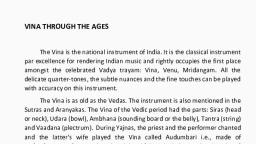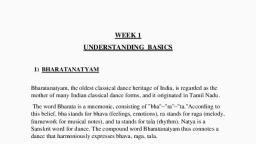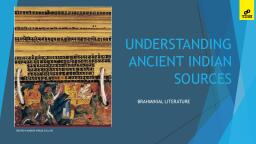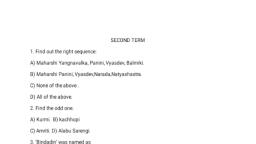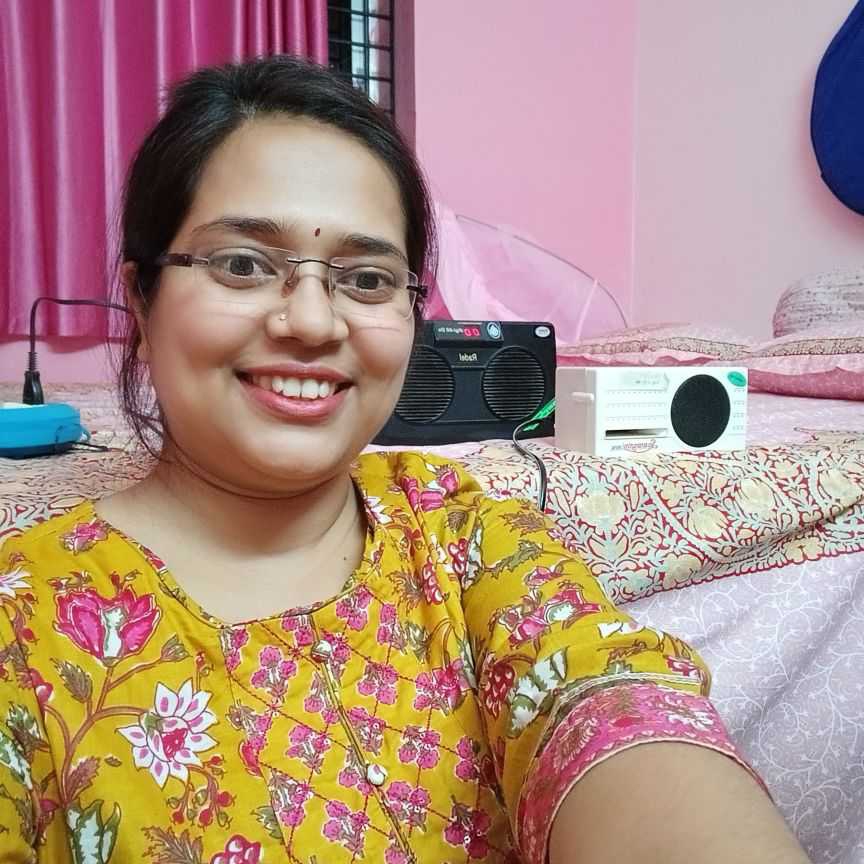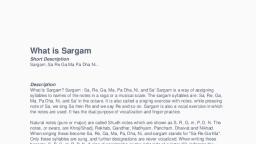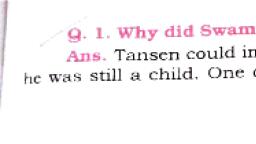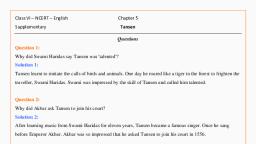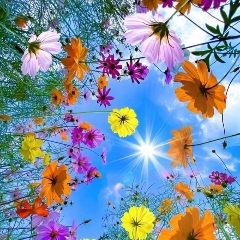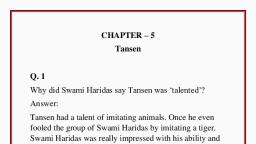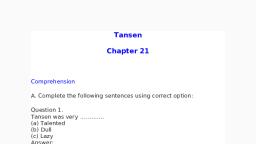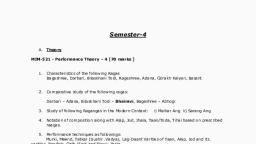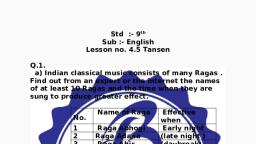Page 2 :
60, , PART 2, CHAPTER, , 1, , SRUTHIS, Sruthi, "The term sfuthi means that which is heard.", "Sfuthi" has some more meanings, but all of them, are related to the prime meaning given above., 1., , The ved'a - because ved'a was learnt by hearing., , 2., , The musical note chosen as keynote by an artist for, a performance., , When one says that his sfuthi is, , 1 112, it means his basic shadja is the short key after, the, , 1, , st, , long key of the harmonium., , In colloquial, , sense, the term sfuthi is used to denote the drone, like thampufa or sfuthi box in a performance., , 3., , Sound- "sfuthikata:" means snake, to which sound, is equal to (graveyard) silence, i.e. which is deaf.
Page 3 :
61, , 4., , Ear, , - "sfuthived'ham" means piercing the lobes, , (for wearing ear-rings, studs etc.), , 5., , Some news that is generaly spread., , 6., , the star "Sfavana". Sfavana also means hearing., , 7., , Hypotenuse of a triangle., , The word, , karnam (which means ear) is also used, to denote the hypotenuse., All these meanings are related to sound or ear, (which is the organ for sensing the sound)., "A Sfuthi is a note of minute pitch which a, refined and trained ear can distinguish., , It is the, , smallest audible difference of pitch. It is a fraction, of a semitone." 1, , In, , the history, , of, , world, , music,, , Indian, , music, , occupies the earliest place among other countries in, using the quarter tones., , 1, South Indian Music -Book IV - P.Sambamurthy -Indian Music Publishing House, Madras Page 101 - Para 3
Page 4 :
62, , Sfuthis are the sounds of smallest variation in, frequency, , that, , trained ear., , can, , be, , distinguished, , by, , a, , musically, , Along with the twelve universal swafas,, , they play an important part from behind, in one or other, form, in different ragas., , It is these sfuthis that lend, , colour and charm to our music., , Various lakshanakaras and scholars have dealt with, sfuthis., , In the Narad'eesiksha of, , can come across, variations, , i.e., , the reference, sfuthis., , After, , 1, , st, , century itself, we, , of these microtonal, Narad'a,, , the, , next, , lakshanakara dealing with sfuthis was Bhafatha., , The, , concept, , of, , twentytwo, , sfuthis, , admits, , of, , twentytwo units of audible differences (sfuthis) in one, octave., , Since an octave was comprised of seven notes, , even at that time, attempts were made to locate the, intervals or the units of audible difference by which each, note of the scale was positioned in the octave., , If a, , note say r is at a distance of four units of audible, difference from the nearest lower note i.e. s, the noter, is said to be of four sfuthi values or intervals.
Page 7 :
65, , In, , fact,, , information., , both, , the, , quotes, , convey, , the, , same, , The first sloka gives the number of sfuthis, , to the notes starting from ri, as if the string of the, instrument (harp) is tuned to sa., , The next sloka shows, , the sfuthis of notes commencing from sa, which would be, true if the harp is tuned to ni., , Thus both the tuning i.e., , sa and ni are covered by these slokas., , This, , establishes, , that, , twentytwo, , recognised and accepted by Bhafatha., , sfuthis, , were, , The concept of, , twentytwo sfuthis continued to gain prominence, as is, evident from the Brhad'd'esi in which Mathanga mentions, about twentytwo sfuthis and also about the use of, Dhruva Veena and Chala Veena to derive the sfuthi, varieties., As such, the positions of the notes are as under., , Note (from n), , s, , r, , g, , m, , p, , d, , n, , Sfuthi Value, , 4, , 3, , 2, , 4, , 4, , 3, , 2, , Cumulative, Position, , 4, , 7, , 9, , 13, , 17, , 20, , 22
Page 8 :
66, , The sfuthi values indicate the number of intervals., The total of the sfuthi values or intervals is twentytwo., Three types of intervals can be seen in this table., , 1., , The interval of four sruthis., , Since the value is, , maximum, this is called Major Interval., 2., , The interval of two sfuthis., , Since the value is, , minimum, this is called Minor Interval., 3., , The interval of three sfuthis., , Since the value is the, , average or mean of the above two, this is known as, Mean Interval., , Mad'hyama Gfama, Mad'hyamagrama, structure, , from, , had, , only, , one, , the shadjagrama., , The, , was, , panchama,, , later, , identified, , mrd'upanchama,, , and, , panchama was, , named, , as, , laghupanchama,, , panchama, thrissfuthi panchama etc., 40/27., , in, , It is this panchama, , lowered by a pramana sfuthi 81/80., that, , difference, , chyutha, kaisiki, , Its frequency is
Page 9 :
67, , Positions of the notes in Mad'hyamagfama are as, under., m, , p, , d, , n, , 5, , r, , g, , Sfuthi Value, , 4, , 3, , 4, , 2, , 4, , 3, , 2, , Cumulative, Position, , 4, , 7, , 11, , 13, , 17, , 20, , 22, , Note, , The difference in the positions of the notes of, Shadjagfama and Mad'hyamagfama is evident from the, table given below., Sfuthi values - Comparison, Note, , s, , R, , G, , M, , p, , D, , N, , Shadjag fa ma, , 4, , 3, , 2, , 4, , 4, , 3, , 2, , Mad'h ya mag fa ma, , 4, , 3, , 2, , 4, , 3, , 4, , 2, , -1, , +1, , Difference, , The value of panchama in mad'hyamagfama is lower, by a sfuthi compared to the value of panchama in, Shadjagrama (3 - 4 = - 1)., panchama, , in, , Shadjagrama, , The cumulative position of, and, , Mad'hyamagrama, , is, , seventeen and sixteen respectively. But, when d'haivatha, is reached, the cumulative values become twenty in
Page 10 :
68, , each, since the interval of d'haivatha of Mad'hyamagfama, is higher by one sfuthi., , Shadjagfama and Mad'hyamagfama were downward, scales like the sama scale., were ca11ed, , The notes of Shadjagfama, , S ud'd'ha swaras ., , Kudumiyanmalai, , inscription, , of, , Pud' ukk6ttai, , also, , bears reference of Shadjagfama and Mad'hyamagfama., , "It is of interest, , to know, , that the, , mentioned in the inscription is, and not Shadjagfama., , first, , raga, , Mad'hyamagfama, , The frequency of the notes, , figuring in Shadjagfama is -, , Note, , s, , r, , g, , m, , p, , d, , n, , Freqi,-ency, , 1, , 10/9, , 32/27, , 4/3, , 3/2, , 5/3, , 16/9, , that is 4 - 3 - 2 - 4 - 4 - 3 - 2 in terms of, interval., , This is the scale of sama, the primordial, , scale corresponding to the Khafahafapriya of South, Indian Music and the Khafid'hat of North Indian, Music. The sud'd'ha scale of ancient Tamil music was, the, , Mad'hyama, , moorchhana, , of, , Shadja, , gfama,
Page 11 :
69, , having the sfuthi 4 4 3 2 4 3 2 for the seven, swafas., , In the Mad'hyamagfama, the panchama is, , flattened by a Pramana sruthi and if this one is, again resorted to the frequency of 3/2, we get the, sud'd'ha scale of ancient Tamil music.", , 6, , Since the harp accompanying the saman chant was, tuned to ni, the derivations of the intervals were from, nishada., , The distance of s from n was found to be four, , sfuthis., , As a result, this four was attached to s, saying, , that s = four sfuthis., , Students are confused when they, , come across the table giving four sfuthi values to s and, four sfuthis to p., , The reason has been found to be, , missing of a simple clarification, , - that the number of, , sfuthis given to each note indicates the number of sfuthi, intervals / units by which that note is distant from the, previous, , note., , Instead of, , furnishing, , the, , values, , in, , tabular form, charts like the ones furnished here would, be easier to explain and understand., , 6 A Monograph on Kudumiyanmalai Inscription on Music - 1986 - Dr.V.Premalatha - printed, at Kanmani Printers, Madurai - Page 12-13
Page 12 :
70, , Positions of notes on string tuned to 'n', , (4-3-2-4-4-3-2), , I ' I I ' II I II I ' I, , 1 2 3 4 5 6 7 8 9 10 1 2 3 4 5 6 7 8 9 20 1 22, , I I, , I I I, , r, , s, , g, , m, , d, , p, , n, , Positions of notes on string tuned to 'n', , (3-2-4-4-3-2-4), , 11, 1, 11, 11, 11, 1, 1, 1, 1, 1, 1, 1, l, l, l, l, l, , 0 1 2 3 4 S, , r, , 6 7 8 9 10 1 2 3 4 5 6, , m, , g, , p, , 7 8 9 10 1 22, , d, , n, , s, , Samvad'ithva, , Bhafatha has classified swafas into four on the, basis of samvad'ithva., , They are Vad'i, Samvad'i, Vivad'i, , and Anuvad'i., , Vad'i:, , Samvad'i:, , It is the principal note occuring in a faga., Samvad'ithva, , means, , consonance, , or, , Swafithabhava. This is the Shadja - Panchama
Page 13 :
71, , relationship between the notes. p is, , Naturally, the, , 13 sfuthis away from the lowers., distance, , of, , upper s, , (22-13=) 9 sfuthis., , from, , p, , (3+2+4+4=), , is, , (3+2+4=) or, , Therefore, Samvad' ithva may, , be defined as the 13-9 or 9-13 sfuthi relationship, between, , notes., , Thus,, , the, , notes, , forming, , the, , samvad'ithva relationship are known as samvad'i, swaras., E.g., , s-p, s-m,, , r-d,, , g-n, , in, , Shadjagfama., , In, , mad'hyamagfama, there is no samvad'ithva between, s-p, because the relationship is 12-10., , It may be, , noted that samvad' ithva was the basis used for, introducing new notes at the period of Samika., , Vivad'i:, , Swafas having only two sfuthi differences, , in between are viad'is E.g. r-g, d-n. Naturally the, relationship is 2 -20 sfuthis., , Anuvad'i:, , The swafas other than vad'i, samvad'i and, , vivad'i are known as anuvad'i swafas., E.g. r, g, d,, , & n are anuvad1s for shadja., , rishabha, s, m, p and n are anuvad'is., , For
Page 15 :
73, , applied mathematics and aesthetics together, thus ruling, out the possibility of occurrence of two mad'hyamas in a, mefakartha raga., Moorchhanas, Shadja, mad'hyama and gand'hara were taken as the, basic notes and sruthibhed'a was applied., sets of scales were derived., , Thus, three, , Moorchhanas were derived, , by shifting the tonic note to each note of the gfama. i.e., through gfahaswafabhed'a. They were the moorchhanas, of, , the, , appropriate, , While, , gfamas., , gramas, , were, , downward scales, moorchhanas were upward scales., , Moorchhanas of the Shadjagfama, , 1., , Uththafamand'ra, , s, , r, , g, , m, , p, , d, , n, , s, , 2., , Rajani or Ranjani, , n, , s, , r, , g, , m, , p, , d, , n, , 3., , Uththarayatha, , d, , n, , s, , r, , g, , m, , p, , d, , 4., , Sud'd'ha Shadji, , p, , d, , n, , s, , r, , g, , m, , p, , 5., , Matsafeekrtha, , m, , p, , d, , n, , s, , r, , g, , m, , 6., , Aswa krantha, , g, , m, , p, , d, , n, , s, , r, , g, , 7., , Abhirud'gatha, , r, , s, , n, , d, , p, , m, , g, , r
Page 16 :
74, , Moorchhanas of the Mad'hyama Gfama, , 1., , Sauveefi, , m, , p, , d, , n, , s, , r, , g, , m, , 2., , Harinasva, , g, , m, , p, , d, , n, , s, , r, , g, , 3., , Kal6panata, , r, , g, , m, , p, , d, , n, , s, , r, , 4., , Sud'd'ha mad'hya, , s, , r, , g, , m, , p, , d, , n, , s, , 5., , Margi, , n, , s, , r, , g, , m, , p, , d, , n, , 6., , Paufavi, , d, , n, , s, , r, , g, , m, , p, , d, , 7., , Hrshyaka, , p, , d, , n, , s, , r, , g, , m, , p, , Moorchhanas of Gand'hara gfama, , 1., , Nand'i, , g m, , p, , d, , n, , s, , r, , 2., , Visa la, , r, , g, , m, , p, , d, , n, , s, , r, , 3., , Sumukhi, , s, , r, , g, , m p, , d, , n, , s, , 4., , Vichithra, , n, , s, , r, , g, , m p, , d, , n, , 5., , R6hinee, , d, , n, , s, , r, , g, , m p, , d, , 6., , Sukha, , p, , d, , n, , s, , r, , g, , m p, , 7., , Alapa, , m p, , d, , n, , s, , r, , g, , g, , m
Page 17 :
75, , Jathis, Gfama, , was, , originally, , a, , scale, , of, , seven, , notes., , Shadjagfama and mad'hyamagfama were two such scales., Gfamas gave rise to moorchhanas. There were seven, moorchhanas from each gfama and in total there were, fourteen or chathurd'd'asa moorchanas., ones, , were, , deleted, , moorchhanas remaining., , and, , there, , were, , The common, only, , seven, , They were called jathis., , Grama - Change of Concept, Later, gfama came to be known as a collection of, all the sud'd'ha and vikrtha swaras used in music i.e. the, chromatic scale., , Mathanga was the first person to define, , gfama in this sense., "He says that even as the members of a joint, family live together,, , so too all the swaras are, , brought together under a gfama.", , 8, , "A gfama was an unsingable group scale, so, to speak, consisting of all the Sud'd'ha - Vikrtha, , 8 History of South Indian Music -Book IV - P.Sambamurthy -Indian Music Publishing House,, Madras - Page 85
Page 18 :
76, , swaras collected together and preserved, as such,, for the purpose of selecting, from that group scale, any desired set of seven notes with a graha or, starting point which set, when sung in the natural, order of ascent and descent was called moorchhana, and, , which, , when, , a, , harmonic, , individuality, , was, , estab I ished with the he I p of am sa, nyasa, v ad'i and, samv ad'i etc. took the nam e of j athi. ", , 9, , The concepts of gfama, moorchhana, jathi etc. are,, at present, only of academic and antiquarian interest,, though they marked important stages in the development, of Indian music., , Derivation of Twentytwo Stuthis, It is unanimously accepted by the musicologists, that, , twentytwo, , sfuthis, , were, , derived, , through, , the, , Dhfuvaveena - Chalaveena experiments., Dhfuvaveena and Chalaveena were veenas of harp, type., , These veenas were chosen because they were, , experimental veenas., , The Chalaveena was called so, , because its frets were movable., , They were having seven, , 9 The Question of Gfamas in JRAS 1936 - M.S.Ramaswamy Ayyar - Page 632
Page 19 :
77, , strings each tuned to the notes of shadjagrama., , So,, , both the instruments were tuned as -, , I : I : I : I : I : I : I : I, The, , Dhruvaveena, , was, , kept, , constant, , and, , the, , panchama string of the Chalaveena was flattened by a, pramana, , Sfuthi, , so, , mad'hya magrama,, , that, , which, , it, , gave, , were, , the, , the, , same, , notes, , as, , of, , those, , of, , shadjagrama but for a flattened panchama., , If, , these, , two, , scales, , are, , verified,, , pa, , of, , the, , shadjagrama was on the 17 th sruthi whereas that of the, mad'hya mag ra ma, , was on, , the, , 16 th •, , Th is, , audible difference of pitch and the, sruthi interval i.e. pramanasruthi., , is the, , least, , lowest of an, , eka, , Bharatha started his, , experiment on pa string because he could demonstrate, pramanasruthi only by this way., , Now, each note of the, , Chalaveena was flattened by one Sfuthi like pa., , Now the, , Chalaveena produced the same shadjagrama notes, but, totally a sruthi below Dhruvaveena., , Again the pa of the, , Chalaveena, , Sfuthi, , was, , lowered, , by, , one, , to, , make, , it
Page 21 :
79, , chosen and tuned to the scale of Sa gfama, that is, the seven strings of each veena were tuned to the, notes of the following frequencies., , s, , r, , g, , m, , p, , d, , n, , 1, , 10/9, , 32/27, , 4/3, , 3/2, , 5/3, , 16/9, , These two seven stringed veenas were of the harp, type and were played on open strings.", , 2., , 10, , "Take two vinas with 22 wires each and tune as, follows., note., , Let the first wire give the lowest possible, , The next a note a little higher and so on, so, , that between the notes given by any two adjacent, wires a third note is impossible., , These successive notes are the Sruthis. Sa will, stand on the fourth wire, being a Svara of four, Sruthis, Ri will be on the third wire counting from, the fifth, Ga which has only two Sruthis will fall on, the second counting from the eighth; Ma being of, four Sruthis on the fourth counting from the tenth,, 10 South Indian Music Book V - 4th Edition - 1982 Publising House, Madras 1 - Page 48, , Prof. P. Sambamoorthy-Indian Music
Page 22 :
80, , Pa on the fourth, counting from the fourteenth;, Dha on the third after Pa, Ni on the second after, Dha; Ni will fall on the twentysecond Sfuthi", , 11, , The former quote is about Bhafatha's experiment, with the two veenas., seven strings each., , The veenas used therein have, It is stated that the veenas are, , tuned to shadjagfama and the lowest note tuned is, mentioned as shadja., , The latter quote refers to veenas of twentytwo, String S,, , 0f, , 5 ar 11 gad'eVa ., , The, , lowest, , note, , tuned, , is, , mentioned as nishad'a, and shadja stands on the fourth, string., , This leads us to infer that Sarngad'eva repeated the, veena experiment with twentytwo strings to investigate, further into the concept of twentytwo sfuthis already, arrived at by Bhafatha using the seven stringed veenas., Otherwise, he could have used the same seven numbers, of strings., , 11 Karunamirtha Sagaram on Srutis - First Book - 1984 -Rao Sahib M. Abraham Pandither, Asian Educational Services, New Delhi - Page 244 - - Para 4 & 5
Page 24 :
82, , Like the ekassruthi interval, a d'visSfuthi interval, has two values., , Poorfia d'visSfuthi interval or diatonic semitone 16/15 - 112 cents., , Nyoona d'vissruthi interval - 135/128 or 92 cents, , A thrisSfuthi interval has a constant value i.e. 10/9, - 182 cents and is equivalent to the minor tone., , A chathusSfuthi interval also has got a constant, value. i.e. 9/8 or 204 cents., , A panchassruthi interval is equivalent to 32/27 294 cents., , A shadSfuthi interval has the value 6/5 - 316 cents., , So,, , the, , total, , number of intervals, , including, , the, , va rieties of ekasSfuth i and d'visSfuth i is nine., , In the increasing order of pite,h, it is presented in, the tabular form.
Page 27 :
85, , 112 -90 = 22 cents, , The, Sfuthis, time, , presence, , were, , OR, , fraction 81/80, , and, , the, , identified, , back., , There, , modification., , The, , is, , and, , application, realised, , only, , one, , twentytwo, , of twentytwo, , scientifically, improvement, , sruthis, , were, , distributed, , over the sapthaswaras allotting, , one, , for, , sruthi, , each, , note., , E.g., , In, , long, or, , initially, , more than, , shadjagrama,, , the, , distribution is as -, , s, , r, , 9, , m, , P, , d, , n, , 4, , 3, , 2, , 4, , 4, , 3, , 2, , But later on sa and pa were treated as aVikrtha, swaras or swaras without varieties and were assigned, one sruthi each. The remaining five notes were assigned, four sruthis each., , Thus 4 x 5 = 20,, , 20+1+1= 22., , modified table appears as under., , s, , r, , 9, , m, , p, , d, , n, , 1, , 4, , 4, , 4, , 1, , 4, , 4, , The
Page 28 :
86, , The above derivations helped to place the sud'd'ha, swaras i.e. the notes of the sama scale on the twentytwo, sfuthi chart., , These sfuthis were derived through the cycle of, fourths and fifths also. Shadja - panchama and shadja mad'hyama are the most consonant pairs of notes, with, , samvad'ithva or swafithabhava., , If sa is 1, its panchama, , is 3/2 and mad'hyama is 4/3., , Cycling these two, , fractions or values, it was possible to find out consonant, intervals in the octave., , Thus it was a scientifically, , proved phenomenon., , Different views on "Sruthis", Panditharad'hya, , Chafithra of, , Pa I k ur k i, , S 6 manatha, , Kavi also refers to the number of sfuthis as twentytwo., At the same time, various other scholars have tabulated, the number as 24, 27, 32, 48, 53, 96 etc., , But, after so, , many experiments and observations, the widely accepted, number is 22., , The glory and individuality of Indian, , music lies in the usage of these sfuthis along with the, prominent notes of a raga.
Page 29 :
87, , The, , comparison, , of, , the, , number, , of, , sfuthis, , i.e., , twentytwo to the nadi system, by S6manatha in his, Ragavib6d'ha, is quite interesting., , He says that three, , knots, , fibrous nerves, , of twentytwo, , delicate and, , are, , present in the human body and that they have effect on, the throat in determining the twentytwo sfuthis., , Table of Clement 12 (furnished on page 89) shows a, total number of 24 sruthis., , He introduces two more, , sfuthis i.e. the 11th one with 324 vibrations per second, and the 19 th with 420 vibrations per second., , Subramania Sastrial has formulated a table of 54, sfuthis. 13, , Karunamirtha Sagaram reads thus - "In the, , table 11 which is appended, we have shown how he, proceeds by thirty ones in the sa-pa series, the order of, their procedure and the particular sruthis he selects to, make up his 22., , These have been specially underlined., , In the same way in the next side of the same table, we, have shown his system of arriving at the, , 53 steps, , proceeding by twenty two-s in the sa-ma series and have, , 12 Karunamirtha Sagaram on Srutis - First Book - 1984 -Rao Sahib M. Abraham Pandither, Asian Educational Services, New Delhi - Page 262, 13 Ibid - Page 294 - 295
Page 30 :
88, , underlined the 22 sruthis he selects out of them in the, third column., , These have, , been, , calculated on, , the, , principle of 1200 cents for an octave with 701.955 for, 2/3 or pa and 498.045 for 3/4 or ma", , Raja Sir Saurendra Mohan Tagore has given the, names of 66 sfuthis which is provided on page 90., , An, , 18 th, , century, , manuscript, , in, , the, , Tanjore, , Saraswathi Mahal Library by name Meladhikara Lakshana, (MS No. 11604) gives nomenclature for the twentyfour, sfuthis. 14, , Among these 24 sfuthis, sruthis no. 8 and no., , 22 are two extra sruthis. (Table provided on page 91)., , 14 History of South Indian Music -Book IV - P.Sambamurthy -Indian Music Publishing House,, Madras - Page 122-123
Page 31 :
89, , Table, showing the Srutis of the Hindustani Music in India, in accordance with Clements' Views, , No., , Name, , 1, , 2, , Fraction showing F ractlon for the Decimal, fractions, the position of, Intervals of, other swarams or srutls, srutls granting, Tonic Sa is 1, 3, , s, , 1, , 1., , Ri1, , 20/21, , 2., , Ri2, , 3., , Position of, srutls In a, wire of 32, inches, , Cents, , Cents, for the, Interval of, srutls, , 4, , 5, , 6, , 7, , 8, , *, , *, , *, , *, , *, , No.of, vibrations, of each, sruti, granting, tonic, , Sa=540, 9, , No. of, vibrations, of each, srutl, granting, Tonic, Sa=240, 10, , *, 540.00, , 240.00, , 84, , 567.00, , 252.00, , 27, , 576.00, , 256.00, , 71, , 600.00, , 266.67, , 204, , 22, , 607.50, , 270.00, , 27.00, , 294, , 90, , 640.00, , 284.44, , 0.8333, , 26.67, , 316, , 22, , 648.00, , 288.00, , 24/25, , 0.8000, , 25.60, , 386, , 71, , 675.00, , 300.00, , 64/81, , 80/81, , o.7901, , 25.28, , 408, , 22, , 683.44, , 303.75, , 16/21, , 27/28, , 0.7619, , 24.38, , 471, , 63, , 708.75, , 315.00, , 0.7500, , 24.00, , 498, , 27, , 720.00, , 320.00, , 0.7407, , 23.70, , 520, , 22, , 729.00, , 324.00, , 0.7111, , 22.76, , 590, , 71, , 759.38, , 337.50, , 2025/3016, , 0.7031, , 22.50, , 610, , 20, , 768.00, , 341.33, , 2/3, , 128/136, , 0.6667, , 21.33, , 702, , 92, , 810.00, , 360.00, , D,, , 40/63, , 30/31, , 0.6349, , 20.32, , 786, , 84, , 850.50, , 378.00, , 16., , D2, , 5/8, , 63/64, , 0.6250, , 20.00, , 814, , 27, , 864.00, , 384.00, , 17., , D,, , 3/5, , 24/25, , 0.6000, , 19.20, , 384, , 71, , 900.00, , 400.00, , 18., , o., , 16/27, , 80/81, , 0.5926, , 18.96, , 906, , 22, , 911.25, , 405.00, , 19., , Nii, , 4/7, , 27/28, , 0.5714, , 18.29, , 969, , 63, , 945.00, , 420.00, , 20., , Ni2, , 9/16, , 63/64, , 0.5625, , 18.00, , 996, , 27, , 960.00, , 426.67, , 21., , Ni3, , 5/9, , 80/81, , 0.5556, , 17.78, , 1018, , 22, , 972.00, , 432.00, , 22., , Ni4, , 8/15, , 24/25, , 0.5333, , 17.07, , 1088, , 71, , 1012.50, , 450.00, , 23., , Nis, , 135/256, , 2025/2048, , 0.5273, , 16.88, , 1108, , 20, , 1024.00, , 455.99, , 24., , s, , 1/2, , 128/138, , 0.5000, , 16.00, , 1200, , 92, , 1080.00, , 480.00, , 1.0000, , 32.00, , 20/21, , 0.9524, , 30.48, , 84, , 15/16, , 63/64, , 0.9375, , 30.00, , 112, , Ri3, , 9/10, , 24/25, , 0.9000, , 28.80, , 182, , 4., , Ri4, , 8/9, , 80/81, , 0.8889, , 28.44, , 5., , G,, , 27/32, , 243/256, , 0.8438, , 6., , G,, , 5/6, , 80/81, , 7., , G,, , 4/5, , 8., , G•, , 9., , M,, , 10., , M,, , 3/4, , 63/64, , 11., , M,, , 20/27, , 80/81, , 12., , M•, , 32/45, , 24/25, , 13., , Ms, , 45/64, , 14., , p, , 15., , 0
Page 34 :
92, , The above-said are the opinions of various scholars, regarding the number of sfuthis in an octave. Though, they are of mere academic interest at present, these, conclusions throw light on the fact that the genius of the, grand old days has never accepted any statement as, such, but went on with their own research to find out the, truth and to arrive at new conclusions.
Page 35 :
93, , Frequencies and Ratios, , It is already stated that the twentytwo Sfuthis were, , derived by using the Dhfuvaveena and Chalaveena., , The, , experiment of Dhfuvaveena and Chalaveena "has been an, indispensable, , subject, , of, , study, , for, , inquisitive, , musicologists in the field of Indian music., , Since the octave had already been identified, the, next attempt was to mark as many notes as possible in, an, , octave,, , There, , with, , were, , no, , frequencies., , audible difference of pitch., , equipments, , to, , measure, , or, , fix, , the, , The only dependable factor was the length, , of the strings., intelligently, , minimum, , It is commendable that the ancestors, , measured, , and, , fixed, , the, , different, , sruthis, , with respect to the length, that too, centuries before the, derivation, , of, , the, , Laws, , modern scientists., , of, , Transverse, , Vibrations, , by, , Had they varied the tension of the, , strings to find out the sruthis, or employed strings of, different thickness, instead of varying the length, the, mathematical accuracy could, , not have been, , achieved., , Since the maximum vibrating length of all the strings, in, both the veenas, were the same, the accuracy of the, ratios, , between, , the, , different, , vibrating, , lengths, , and
Page 36 :
94, , frequencies was ensured., , The concept and use of two, , veenas itself was most scientific and intelligent., , The primary background for all these experiments, dates, , back to, , the, , designing, , of the, , first, , harp., , The, , significant point here is that even in the very old days of, ekaswareegayana, there was an inclination to use a drone, as accompaniment., , It was a big leap, when the open string of the harp, was tuned to a note (., fret, , was, , provided, , facilitated, keynote., , the, , n) below the key note (5) and a, , to, , produce the, , first, , downward, , key, , note, , movement, , (s)., , This, , from, , the, , It may be noted that derivation of the notes in, , the grama, later, was also in the downward order., rat i 0 s 0 f, also, , not e sin, , derived,, , sam v a d'j t h va, , based, , on, , the, , and, , The, , d'v i gun at h v awe r e, , vibrating, , length, , of, , the, , stri ngs. The term d'vig unathva itself was a rrived from the, observation of the ratio of vibrating lengths., a bsence, , of, , freq uency, , va I ues,, , the, , Even in the, , d'vig unathva, , wa s, , established beyond doubt, by this method., , DVigunathva, (sthhayees), , have, , and, been, , the, , names, , referred, , to, , of, in, , the, , registers, , many, , including Sangeetharathnakara of Sarngadeva., , works
Page 37 :
95, , oqch?I{ � �� � �sf,1"�, � l=f� �, , � arfct��:, , ffi"U, , �tntt1(ltt1(: 11, , �qOl�C,qi l@l:, , N'-'f11tltf�i11 '1T alfcf�1R,4e11:, , 11, , 15, , The nad'am emanating from the heart is mand'fa,, the one coming from the throat is mad'hya and the, nad'am from moord'ha (head) is thafa; mad'hya is d'viguna, (doub I e) of mand'fa and thafa is d'viguna of mad'hya., , In the ancient works it is stated clearly that the, frequency, , of, , a, , frequency, , of, , the, , note, , in, , note in, , thafasthhayi, , is, , mad'hyasthhayi., , double, , the, , When, , a, , stretched string of a particular length is damped at the, middle, the frequency of the vibrating segment of the, string is double the frequency of the whole string in, vibration., , Thus, if the note produced by the open string, , is sa of mad' hyasthhayi, half the length of the string in, vibration, , produces, , sa, , of, , tharasthhayi., , exampie of d'viguna relationship., , This, , is, , an, , When it is stopped at, , 1/3 length and the 2/3 is vibrated, the 2;3 rd portion will, , give, , 15, , mad'hyasthhayi, , panchama, , and, , 1/3, , will, , Samgitaratnakara - Vol. I - Adhhyaya 1 - 1943 - Edited by: Pandit S.Subrahmanya, Sastri - The Adyar Library, Madras - Page 66, , give
Page 38 :
96, thafasthhayi panchama. It was through this method, the, frequency of panchama was fixed as 3/2., , The sfuthis were derived upon the principle of, consonance., , They were developed through the cycle of, , fifths and fourths i.e. by s-p, , Ahobala, , also, , has, , and s-m series., , stated,, , in, , his, , Sangeetha, , Parijatha, that Shadja-Panchama bhava was used as the, basic measure to derive the twentytwo sfuthis., , The tables of, , C.S.Ayyar 16 show the frequencies, , obtained from particular parts of the string., observed that, , It may be, , "the product of the ratio of the vibrating, , lengths and the ratio of resultant frequencies" is a, constant, which proves one of the Laws of Transverse, Vibration, vouching the accuracy of sfuthi ratios derived, by the ancestors., , 16, , The Grammar of South Indian (Karnatic) Music - 1976 -C.Subrahmanya Ayyar - Vidya, Sankar, Madras 4 - Page 8-9
Page 39 :
97, , Table of C.S.Ayyar - 1, Notes from, various vi brating lengths of the string, Name of the string = Sa, Damped, length, , Vibrating, length, , Relative, frequency, , Name of note, , English, name, , nil, , Whole, , 1, , Shadja, , Tonic, , 1/2, , 1/2, , 2, , Higher Sa, , The, octave, , 1/3, , 2/3, , 3/2, , Panchama, , True, fifth, , 1/4, , 3/4, , 4/3, , Suddha, Madhyama, , True, fourth, , 1/5, , 4/5, , 5/4, , Anthargatha, gandhara, , Major, third, , 1/6, , 5/6, , 6/5, , Sadharana, gandhara, , Minor, third, , 2/5, , 3/5, , 5/3, , Thrissruthi, Dhaivatha, though known, generally as, chathussruthi, dhaivatha, , Major, sixth
Page 40 :
98, , Table of C.S.Ayyar - 2, Notes from, various vibrating lengths of the s tring, Name of the string = Pa, , Damped, length, , Vibrating, length, , Relative, frequency, , Name of note, , English, name, , nil, , Whole, , 3/2, , Panchama, , Dominant, , 112, , V2, , 3, , Higher, panchama, , 2/3, , 1/3, , 9/4, , Chathusruthi, rishabha, , 1/4, , 3/4, , 2, , Higher shadja, , 1/5, , 4/5, , 15/8, , Kakali nishada, , 1/6, , 5/6, , 9/5, , Kaisiki nishada, , 2/5, , 3/5, , 5/2, , Anthargatha, gandhara, , Ri, , harmonic, on pa, string
Page 41 :
99, Prof., , Helmhotz has determined the positions of, , harmonics and their tonal nature, using resonators. The, tonic cp-s of strings has been calculated as 256. The, relevant table is given below., Table of Harmonic Series, No.of, harmonics, , Sthhayi, , Note, , Cps, , 256, , 1, , 1, , C, , 256, , 1, , 2, , 2, , C, , 512, , 2, , 3, , 2, , G, , 768, , 3, , 4, , 3, , C, , 1024, , 4, , 5, , 3, , E, , 1280, , 5, , 6, , 3, , G, , 1536, , 6, , 7, , 3, , Bb, , 1792, , 7, , 8, , 4, , C, , 2048, , 8, , X, , It has been found that the fundamental tone or the, basic note of a harmony is stronger at the beginning, but, tends to be weak as it progresses., , The lower the ratio of the notes, higher is the, affinity for consonance and vice versa., 5/4, 6/5 is the order of consonance., , In Ragas in which, , the notes of very high ratio occur,, dissonant with the adhara shadjam., , Eg. 2, 3/2, 4/3,, , such notes are, , Generally, it is to
Page 42 :
100, overcome this problem that such notes are sung with, gamakas and not as straight notes., , Harmonics i.e. upto 5 th (3 rd sthhayi) can be picked, up by the trained ear but those beyond 5 th and 7 th is par, audibility. Odd numbered harmonics like the 7 th I, , 9 th I, , 11 th , 13 th etc. are dissonants. But, harmonics below 7 th, and, , all, , the, , other, , even, , numbered, , harmonics, , are, , consonants. The steppings of notes in the series are l 5t ,, , It, , may, , be, , noted, , that, , musical, , frequencies are 40 to 4000 Hz., , limits, , of, , the, , Practically, even the, , higher notes of the third sthhayi are more or less at the, fag end of the enjoyable limits., increases,, , As the frequency, , the sound moves from enjoyable level to, , tolerable level, then to irritating level., , Simultaneously,, , there is a gradual decrease of volume and thus the, audibility also decreases gradually. Finally the sound, fades away as inaudible., , According to the Harmonic Series,, Panchama, , =, , 3/2, , Anthafagand'hafa, , =, , 5/4, , Sud'd'ha mad'hyama = 4/3
Page 43 :
101, , (sj 33514-., , It is interesting to note that panchama is the, arithmetic, , mean, , of, , mad'hyasthhayi, , thafasthhayi shadja i.e. (1+2) +2, , Anthafagand'hafa, , is, , the, , and, , shadja, , = 3/2., , arithmetical, , mad'hyasthhayi shadja and panchama., , mean, , of, , [ 1+(3/2)] +2, , =, , 5/4., Chathussfuthi fishabha is the arithmatic mean of, shadja and anthafa gand'hafa [1+(5/4)] + 2 = 9/8., , We can get 11 values from sa - pa series and 11, values from sa, , -, , ma series and altogether we get, , twentytwo sfuthi values., , The sa-pa series gives, , 1., , sa, , = 1, , 2., , pa, , =, , 3., , pa of this pa = 3/2 x 3/2, , 1, , compound, octave., , X, , 3/2 = 3/2, , interval, , i.e., , =, the, , 9/4, interval, , 9/8, , above, , is, , a, the, , So, to bring back to the middle octave, we, , have to divide it by two., i.e. 9/4, , which, , +, , 2 =, , 9/4, , X, , 1/2 = 9/8., , = ri ( Chathussfuthi fishabha)
Page 44 :
102, 4., , 9/8, , x, , 3/2, , d'haivatha)., , =, , 27/16, , x, , compound interval., , d'ha, , i.e., , 27/16, , 3/2, , ( Chathussfuthi, , = 81/32 is again a, , When brought, , back to the, , same octave, it becomes 81/64 (Anthafa Gand'hafa), (This is sharper by a comma i.e. Relative frequency, 81/80 than 5/4), 5., , 81/64 x 3/2 = 243/128 = ni (Kakafi nishad'a), a, comma sharper than 15/8., , 6., , 243/128 x 3/2, , = 729/256, a compound interval and, , in the mad'hyasthhayi., , It is 729/512, , which is, , equated to 64/45 which is prathi mad'hyama., 7., , 64/45 x 3/2 = 32/15, when we drop an octave, it, becomes 16/15 which is sud'd'ha rishabha., 3/2 = 8/5 - sud'd'ha d'haivatha., , 8., , 16/15, , 9., , 8/5 x 3/2, , X, , = 12/5 which, on drop of an octave, , becomes 6/5 which is sad'hafana gand'hafa., 10., , 6/5 x 3/2 = 9/5 kaisiki nishad'a., , 11., , 9/5 x 3/2, , = 27/10 which, on drop of an octave, , becomes 27/20 which is a comma sharper than, sud'd'ha mad'hyama 4/3.
Page 45 :
103, 27/20 x 3/2, , = 81/40 which, on bringing back to, , mad'hyasthh a yi, becomes 81I80 a com ma s harper, than sa., , Like this we get 11 sruthis by the cycle of fourths also., , = 4/3, , 1., , 1 x 4/3, , sud'd'ha mad'hyama, , 2., , 4/3 X 4/3 = 16/9 kaisiki nishad'a., , This kaisiki, , nishad'a is flatter to that obtained through sa- pa, cycle by a comma interval i.e. 81/80., , 3., , 16/9 X 4/3, , = 64/27 (a compound interval). This,, , on drop of an octave, becomes 32/27, a sad'hafana gand'hafa, which is flatter by a comma, compared to the one in sa - pa series., 4., , 32/27 x 4/3 = 128/81 sud'd'ha d'haivatha a comma, flatter than 8/5 in the previous calculation., , 5., , 128/81 x 4/3, , = 512/243. On drop of an octave,, , becomes 256/243 i.e. a comma flatter than 16/15, sud'd'ha fishabha of sa - pa series., 6., , 256/243 x 4/3, , = 1024/729 which is equated to, , 45/32, a prathi mad'hyama holding the relation of, kakafi nishad'a or 15/8 of panchama.
Page 46 :
104, 7., , 45/32 x 4/3, , 8., , 15/8 x 4/3 = 5/2 which becomes 5/4 or anthafa, , = 15/8 or kaka(; nishad'a ., , gand'hafa when it drops an octave., , 9., , = 5/3 thrissfuthi d'haivatha, a comma, , 5/4 X 4/3, , below chathussfuthi d'haivatha 27/16, 10., , 5/3 x 4/3, , = 20/9, on the drop of an octave gives, , 10/9, thrissfuthi fishabha i.e. a comma flatter than, chathus sfuthi rishabha i.e. 9/8., 11. 10/9 x 4/3, , =, , 40/27 or a comma flatter than, , panchama i.e. 3/2, , As is evident from the, cannot, , get, , the, , above calculations,, , intervals correctly, , in, , certain, , we, , cases., , There are complicated fractions that cannot be simplified, perfectly., , Since it is possible to adopt any level of, , sound as the key note i.e. adhara shadja in Indian, music, the mathematical derivation of the frequencies of, notes are possible only through the application of ratios., , In, , a, , simplified, , experiment, , on, , the, , harmonium, , through the sa-pa method, we can get the notes as, calculated earlier.
Page 48 :
106, may be equal to 2 cents approximately. (mad'hyasthhayi, sa to thafasthhayi sa is 1200 cents, compared to which, this 2 cents is not distinguishable.), , Thus in an octave, there are three major tones (Chathussfuthi, two minor tones (Thrissfuthi, , I, , I, , Major Interval),, , Mean intervals) and, , two semi tones (Dvissfuthi / Minor interval)., , Between the anthafa gand'hafa and sud'd'ha mad'hyama is, a d'vssfuthi interval, , = 16/15. Thus 5/4 x 16/15 = 4/3., , Between kakafi nishad'a and thafasthhayi shadja also is a, d'vissfuthi interval 15/8 x 16/15 = 2., , Interval between sud'd'ha mad'hyama and panchama is a, chatussfuthi interval (3/2) /divided by (4/3) = 3/2 x 3/4, , = 9/8., 13,gvedic Swaras bear the frequencies 10/9 (ri) 1 (sa) and, 8/9 (ni)., , The tables provided by C.S.Ayyar is relevant in this, regard.
Page 56 :
114, "The ratio of the frequency of a note to that of a, lower note is termed the interval between them., , In, , other words, to obtain the interval value between any, two notes, the frequency of the higher note is to be, divided by that of the lower note., It, , consequently, , follows, , that, , a, , lower, , note,, , multiplied by the interval between it and the next higher, note, gives the pitch of that higher note., , 16 I 1 5 = 4 I 3 . II, , Thus 5/4 x, , 20, , If we calculate the value in cyclic cents, then the, value, , of, , mad'hyasthhayi, , s, , is, , zero, , i.e., , and, , that, , of, , tharasthhayi s is 1200., There is a general principle that two consecutive, sruthis should not occur in a raga., , Sud'd'ha meia of Tamil music, From the Silappathikaram of 2 nd century, we come, to know that the Tamil music also used the system of, twentytwo, , Sruthis., , There, , also, , Shadjagrama, , (called, , Arumpalai) was employed as the basis of derivation of, new scales., , 20, , South Indian Music -Book IV - P.Sambamurthy -Indian Music Publishing House, Madras., - Page 108
Page 57 :
115, , Instead of the main sfuthi, they used the term, They resorted to the scale of just, , 'Alaku' or 'Mathra'., intonation., , The, , notes, , of, , their, , sud'd' ha, , mefa, , or, , fundamental scale had the following sfuthis values - 43-2-4-4-3-2., , We also find reference to three kinds of intervals., In, , the, , above, , scale, , there, , were, , three, , chathussfuthi, , intervals (Major tones), two thrissfuthi intervals (Minor, tones) and two d'vissfuthi intervals (semi tones)., , It is, , close to the Hafikamb6ji mefa and so the sud'd'ha seale of, ancient Tamils was fixed as Hafikamb6ji., , The fourth note of Bhafatha's scale i.e. ma when, taken as sa results in Hafikamb6ji., , That means the, , sud'd'ha seale of ancient Tamils was the ma moorcha na of, Sa-gfama., , It, , seems, , that, , most, , of, , the, , 'puns', , are, , derivatives of Hafikamb6ji., , By the modal shift of tonic, seven moorchanas or, scales were derived., Pudumalaippalai,, , They are named as Chempalai,, , Sevvalippalai,, , Vilarippalai and Merchempalai., , Afumpalai,, , Kodippalai,, , The initial notes of these, , scales progress in the ascending order.
Page 62 :
120, names were given on rational basis i.e. according to the, eight aesthetic sentiments and moods., , We, , can, , identify, , these, , jathis, , being, , applied, , to, , certain swaras in particular sancharas, in many ragas, that we come across., , "In the Neelambari raga,, , the rendering of the, , concluding note 'ma' in the phrase-G m p m m, , ), , i, , -can be, , cited as an example of Mrdu type....In the same raga,, the rendering of the note Mad'hyama in the phrase- P M, P N S., , In the same raga, the rendering of the note, , Mad'hyama in the phrase- g m P -can be cited as an, instance of Mad'hya. The mad'hyama in the phrase smp, in K LI ntha fa Vara fi raga is a I so an instance of Mad'h ya. . ., The rendering of the note Deergha Nishad'a in the phrase, rmpNNnd, , and, , Deergha, , Mad'hyama, , in, , the, , phrase, , MMmgpmR in Surutti raga can be cited as instances of, Deeptha. . ., the phraseG, , The rendering of the note Gand'hara in, l, , j, , ', , rs in Asaveri can be cited as an instance, , of Karufia (pathetic)." 22, , 22, , South Indian Music -Book IV - P.Sambamurthy -Indian Music Publishing House, Madras Page 127
Page 63 :
121, The, , phrases, , cited above, , have, , been, , practically, , analysed by the authoress of this thesis and found to be, true., , A few other observations derived on analysis are, , as under., , Dhaivatha of Kamb6ji in the phrase- d, is Deeptha., , In the phrase, , rsnsd'd, , rs n d p d, , , ., , the underlined, , two dhas are of Deeptha type., , Ri in Sahana in the combination r , r , g m p , is, kafufia., , In Bhaifavi, then in- m p d ri, , I, , I, , I, , I, , -is Deeptha., , At the same time the same n in the combination-, , rg r, I, , s n , d p -is pathetic., , s n d ri, , ,,, , l, , , d p -is a phrase in Saufashtram in which, , the ni is Ayatha or stretched., , Thus, the Sfuthi Jathis play a vital role, in the, manifestation and establishment of rasas in ragas., , We have gone through many systems of Sfuthis,, but the number twentytwo is supposed to be the most, meaningful and being identified by the human ear., , The
Page 64 :
122, , other numbers are like overtones that would enrich the, fundamental sfuthi., , Though theoretically a performer is, , unable to identify which sfuthi of ri or ga is being sung, by him, yet in a particular faga, he is very much aware, of the type, extent and manipulation given to it., , For example, whether one knows or not, he will, never sing ri of Mayamafavagaula like ri of Gaufa., , Like, , that, ri of Bhairavi is rendered as a straight note in its, own place, whereas that of Sankarabharanam is sung, with the gamaka - vali., , Here both are chathussfuthi, , rishabhas, but when we analyse the sfuthi values, we, , can, , understand, , that, , Bhairavi, , implies, , a, , thrisruthi, , fishabha while Sankarabharanam implies chathussfuthi, fishabha i.e. 182,, , 204 cyclic cents or 266.60, 2 70, , vibrations per second respectively, with sa =240 (Refer, Dvavimsathi chart given in page 112-113)., , "An, , inscription, , found, , at, , Kudumiyamalai, , in, , Pudukkottai State of the Madras Presidency which seems, to belong to the 7th century, has many references to, Music., , It mentions seven jathis, and a queue of the, , sfuthis as well as 7 swaras. The words antara and Kakafi, are found described in respectively the sharp sfuthis of, ga and ni which is one of the peculiarities of southern
Page 65 :
123, nomenclature today., , It is suggested that the inscription, , is a piece for Samagah to sing and that the peculiar, marks on many of the note signs may be intended to, indicate points of saman singing. 23, , According to Sangeetha Sara Sangraha of Thiruvenkatakavi of Tanjore in, , Telugu,, , there are twentyfour, , sruthis and thirtyfour swarasthhanas for an octave. But, Sangraha choodamani of Govinda Deekshithar followed, Venkatamakhi's, , sixteen, , swaras, , system, , over, , twelve, , swarasthhanas and twentytwo sfuthis tradition., , "All, , the, , twentytwo, , some raga or other., , sfuthi-s, , become, , swara-s, , in, , sruthis actually used in a raga, , attain the status of swaras in that raga and the other, notes remain merely as sfuthis."24, , Though the calculations and scientific applications, form one part of the show, it is only the aesthetic sense, and the sense of ears, which had guided the research, and the development of music from the past., , The, , derivation of twentytwo sfuthis by Bharatha with the, , 23, The Music of india - Second Edition 1950 - H.A.Popley - Association Press , 5, Russel St.,, Calcutta - Page No. 13 para 2, 24, South Indian Music -Book IV - P.Sambamurthy -Indian Music Publishing House, Madras Page 105
Page 66 :
124, help of Dhruva Veena and Chala Veena was also done in, the same manner., , Regarding music, lakshyajnana forms, , the guiding aspect or it bears the torch light, which is, followed by lakshana., , Lakshyajnana goes hand in hand, , with aesthetic enjoyment and judgement., some, , Upanga, , Ragas like, , That is why, , Bilahari have later, , become, , Bhashanga ragas and some older ragas have become of, mere academic interest
Page 71 :
128, , Varna, "Varna" is a particular type of phrase., , An alankafa, , is a collection of Varna, as detailed below., , s, , r g, , m, , - is Afohi varna, since the notes are in, , the Afohanakrama., , m, , g, , -is Avafohi varna as the, , r s, , notes are in Avafohanakrama., , s, , s, , s, , s, , r, , r, , r, , r, , is Sthhayi varna in, , which the same note is repeated several times., , Sanchafi varna is a mixture of all these., , Since gamaka is one of the prime factors in the, formation, development and exhibition of ragas, it will, be incomplete and injustice if Ragas are not spoken, about, while the study of gamakas is carried out., , Raga, Raga is the offspring of melody., Indian music without faga., , There can be no, , The term faga came into, , existence during the time of Mathanga., developed gradually through centuries., , Later on, it
Page 72 :
129, , The literal meanings of the word faga are - beauty,, affection, love, emotion, passion, colour etc., , This leads, , us to infer that the word faga or fagam is chosen to, name the specific musical phrase which is so beautiful by, itself, , and, , is, , capable, , of, , creating, , or, , conveying, , an, , expression / emotion / pleasure so beautifully that we, cannot but love them., , So, faga can be defined as the form created by the, sanchafa of the notes of a particular scale, which are, self-expressive., , Passing, , through the Twenty, , Mela, , pad'dh, ' ath i of, , Ramamathya the ragas fully blossomed during the Mela, Prasthafa Pad'd'hathi of Venkatamakhi., , Ragas attain their individuality through gamakas., It is the gamaka concept that controls the faga concept, and also the melody concept., , Ragas are countless in our, , system of music with an individuality and personality for, each of them., , The individuality is clearly identifiable,, , even in closely allied ragas and Sankeerfia Ragas., , The identity and bhava of a faga change according, to the gamakas figuring therein., , In the so-called sarva-
Page 73 :
130, , swara-gamaka-varika-rakthi, , raga,, , all, , the, , swaras, , are, , rendered with gamaka., , The life and soul of the melodic system of music is, In all systems of music, it is used in one way, , gamaka., or, , other., , backbone., system, , But,, , regarding, , Indian, , Music,, , it, , is, , the, , It is the pivot around which the entire raga, , revolves., , While, , chord, , formation, , gives, , the, , pleasing effect to the harmonic system, the gamakas, give the pleasant effect, form and shape to a raga., , The, , astonishing fact is that it is the very same twelve swaras, that are being sung throughout, whichever be the raga., Yet, , each, , raga, , has, , an, , identity,, , individuality, , and, , personality of its own. Our system has got countless, ragas and they differ from each other, from the point of, view of the gamakas used., , South Indian Classical Music is so rich in gamakas, that, , we, , can, , never, , think, , of, , a, , geetha,, , sapthaswaras sung in a plain manner., , or, , even, , Gamakas are, , comprised of subtle sruthis that are essentials of the, individual raga., , The colour or the individuality of a raga, , is determined by the nature of various gamakas present, therein, along with the swafa features., , We have got so, , many janya ragas from the same Janaka raga and even
Page 74 :
131, , with the same arohana and avarohana, yet they differ, distinctively due to the application of gamakas particular, to them., , In, , Naradeesiksha,, , reference, , is, , made, , gamakas used in sacred and secular music., , of, , ten, , Mathanga, , was the first one among lakshanakaras to make use of, the term gamaka in his definition of raga,, , may be, , perhaps the concept of raga was gaining a distinct form, during his period., , Reference of the term gamaka is, , available in the Sound'aryalahari of Ad'i Sankara., , The, , first line of the 59 th sloka is the piece of reference., , Here, Sree Sankara addresses Devi, as the one who, is very efficient in the art of music that has the divisions, - gathi, gamaka and geetham., , In the latter part of the, , sfoka, when he describes the beauty of the three lines on, the neck of, , Devi, comparison is made to the three, , gramas (Shadja, Mad'hyama and Gand' h ara) that are the, sources of many sweet ragas.
Page 77 :
134, , These gamakas are briefed below., , 1., , Thiripa (Nokku), Tiripa is a stress applied to one note in a phrase,, and is denoted with a "x" mark over the stressed, note., , The "r" in the phrase, , n, , s, , r, , s, , in Natta, , raga is a popular example., , 2., , Sphuritha Sphuritha is the stress given to the second note in, a janta swara,, , which, , projects, , the, , lower, , note,, , though faintly, between the two notes., , 3., , Kampitha Kampanam means shake., the, , Naturally, Kampitha is, , shake given to a note., , Whether is long, , (d'eergha) or short (hrasva), it keeps itself within, the boundary of the note., , The shake of the g in, , Atana, Anand'abhairavi and Dhanyasi ragas are well, known examples for Deergha Kampitha., , The shake, , given tog in Sreeraga is a Hrasva Kampitha.
Page 78 :
135, , 4., , Leena As the name indicates, it is the soft merging of a, note into another note., , 5., , And'6 fitha And'olitha, , is, , the, , application, , of, , and'ofanam, , swinging. This indicates the pace also. "Holding on, a note for some time and then pulling the string or, gliding on it so as to reveal a higher note.", 6., , 5, , Vali True to the indication of being applied on string, it, is a veeiia gamaka. It is the manner of producing, the effect of two or three notes from the same fret, (of the veeiia) by the deflection of the string., , 7., , Thribhinna This is a veeiia gamaka. As the term suggests, this, gamaka is the harmonic effect produced from three, ("Thri") different ("Bhinna") frets and strings, on, the veeiia simultaneously or successively., , 5, South Indian Music -Book IV - P.Sambamurthy -Indian Music Publishing House, Madras., - Page 137
Page 79 :
136, , 8., , Kufufa The production or beautiful projection of another, note from the swafasthhana of a certain note is, Kufufa., , 9., , Ahatha Producing a note with, , This is a veena gamaka., , stroke and sounding a second note without stroke, is ahatha., 10., , Ullasitha, Jafu or glide Jafu is of two types - upward and downward., , "This, , is obtained by starting on a note and reaching a, higher or a lower note, as the case may be, by, gliding over the intermediate notes, without at the, same time giving the impression of the individuality, of the intermediate notes.", 11., , 6, , pf avitha -, , The literal meaning is "dipped" or "sprinkled., , 7, , is stated that this is a variety of Kampitha., , 6, , South Indian Music -Book IV - P.Sambamurthy -Indian Music Publishing House, Madras., - Page 137, 7, Samskrutha Malayala Nighantu 3rd Edition 1996 Kanippayyur Sankaran, Nampoothirippad - Panchangam Pusthakasala, Kunnamkulam - Page 765, , It
Page 80 :
137, , 12., , Gumphitha Literal meaning is "stitching and binding" (of book, etc.). 8, "This is called Humpitha by Govinda Deekshithar., This gamaka belongs to vocal music., , The tone is, , slender at the start and goes on increasing on both, volume and pitch, like the notes of the Ekkalam., The progression may also be the other way., this is another variety of jaru., dimensional gamaka., , This is a two, , (The note of the siren is, , good example of Humpitha Gamaka)", , 13., , Thus,, , 9, , Mud'ritha Mud'ritham means hidden or closed. As suggested,, this is a method of singing with closed mouth., , 14., , Namitha Namanam means the act of "bowing humbly" or, "prostrating"., , Hence, , namitham, , indicates, , "slenderisation" of the tone., , 8, , Kanippayyur Sankaran, Samskrutha Malayala Nighantu 3 rd Edition 1996 Nampoothirippad - Panchangam Pusthakasala, Kunnamkulam - Page 417, 9, South Indian Music -Book IV - P.Sambamurthy -Indian Music Publishing House, Madras., Page 138
Page 86 :
143, , s s, , n, , n, , d, , In, , d., , this, , rendering,, , automatically, the just higher note will be, present unnoticeably - like srs, , 6., , ns n ., , Thifupam (Nokku) In a phrase,, , when one swafa is stressed,, , that, , gamaka is known as Thirupam or Nokku - like, w, , w, , �, , w, , w, , 1/\1, , nsg;r mp; nsrgmp; nsrs;, , 7., , Ahatham It is a blow given while coming back from a higher, or lower swafasthhana., (i), , It is of two types., , Ravai - it is a stress on the former note, with or without a separate stroke in, speedy return from a higher note to a, lower note, v, ppm, , (ii), , v, , Mmg, , v, , Rrs, , Khandippu - This is of two types., (a) Coming down from a note with strike,, to a lower, (without, , note,, , stopping), , and, , immediately, , with, , another
Page 87 :
144, , stroke to a still lower note is called, Khandippu., , E.g., , PmG, , PgR, , PrS., , (Swaras are PG PR PS), (b) It is the same as, , Khandippu, , (a),, , while coming down to a lower note, through, , the, , intermediate, , anuswafa, , the striking is stopped to make it, unnoticeable, and glides down as in, the case of Erakka Jaru - like Pm\R, Mg\R Gr\S (Swaras are PR MR GS), , 8., , Vali Producing the chhaya of two or three notes from, the same swafasthhana by deflecting the string, is, Vali., , It is of three varieties., , n, , (1) Eg. nD, , n, , dN., , In the latter, pluck the string with, , the finger on d deflect the string to produce n, and again come back to the original position, and strike the next sthhana only., , This comes, , in Punnagavarali sancharas., w, , n, , (2) A double swafa prayoga like S \ n d n D p., Here, give a single stroke at d and deflect the, string in such a way as to reveal n with subtlity
Page 89 :
146, , Likewise with a single plucking, , (2) Erakka jaru:, , the gamaka glides down from a higher note to, a lower note., , ., , s \ n, , 10., , ., , s \ m, , s\d s\p, , s\g., , Humpitham:, From a single swafa, if the gamaka travels through, 3 or more swafas and reaches an upper swafa or, even beyond the octave with humkafa or likewise in, the reverse, it is called humphitham., , 11., , Kufulam: It is also called Othukkal or Orikai., (1), , Othukkal (x)- It is the mode of playing two or, more swafas from the same swafasthhana by, deflecting the string and at the same time, plucking the string., plucked, , with, , returned to r ., , another, , R is, , In R g r, , and from the same, , produced, , X, , E.g., , sthhana, , stroke, , and, , g, , is, , again, , In the example -, , X, , r / m\ g r , all the swafas are played in the, Rishabha sthhana itself with stroke., , This is a, , veefia gamaka and is equal to jafu in vocal, music.
Page 90 :
147, , (2), , Orikai - With a single stroke, if one to, three swafas are played efficiently with, modulation, it is called Orikai. Eg., ns dn, '"'I("', , s n, , 12., , '"'I("', , d, , pd, , mp gm rg, , '"'I("', , '"'I("', , p, , '"'I("', , m, , g, , '"'I("', , r, , s, , Thribhinnam., Thribhinna is the method of placing forefinger and, middle, , finger, , on, , a, , swafasthhana, , touching, , the, , mandra Panchama and mandra sarini strings and, plucking the threee strings with the right hand, either simultaneously as one by one., , 13., , Mud'ritham., The manipulations occurred in the swaras by closed, mouth singing forms the gamaka Mud'ritham., , This, , pertains to vocal music only., , 14., , Namitham., The gamaka contained in the swaras rendered with, modulations at, , the, , same, , time, , highlighting, , the
Page 92 :
149, , Excerpts from details given by Vidya Sankar, about d'asa vidha gama kas with ii I ustrations from, krthis, are given below., , 1., , Kampitha Kampitha is a shake in which oscillation is, from a higher swara to a lower one., the, , phrase, , of-, , Sankafabhafanam,, pm, , g, , M, , P, , -in, , the, , raga, , M is produced as-, , pm, , -in a wavy manner., , oscillations is two., of oscillations,, introduced, , The number of, , In cases of more number, , Subbafama, , extra, , e.g. in, , wavy, , Deekshithar has, , lines., , gamaka has two more varieties., , Kampitha, The first one, , is an oscillation from the lower to the higher, swara., , E.g. In the krthi Jesinatella in Th6di,, , the first line of the charanam starts withG, , -in which, the starting point is lower, , Sud'dha Rishabha., , G, , G, , G, , G, , Ra ma sri, , Thyagarajaprema
Page 94 :
151, , 4., , Nokku:, , In the raga Mayamafavagaufa, in the, , phrase- s r g m -the note g is pulled downwards, from m quickly that it becomes a stress., , Such pull, , is called Nokku. Its sign is " w " ., , 5., , Ravai:, , In some swafa combinations like- p, , m -, , before coming to m , the p is repeated softly with a, touch of sphuritha;, gamaka, , generally, , p m is produced as Ppm., occurs, , in, , the, , This, , avaf6hana, , or, , descent. The sign used for Ravai is "A."., , 6., , Khandippu:, , This also comes in the descent., , It is, , a nokku with a pause between two alternate swafas, backward., , It applies to the intermediate swafa to, , which the khandippu is given., , E.g. in the raga, , Sufutti , in the phrase- mg pmr -and in Kalyani in, the phrase-, , pmrs, , with a slide from g, here., , -the swafa, , r, , is produced, , , which becomes an anuswafa, , The shade comes after a break from the, , intermediate swara g., , The sign for Khandippu is, , v., , In ravai and khandippu, since the existence of the, intermediate swara is apparent, the anuswafa is, written above the swara line with their respective, signs.
Page 95 :
152, , 7., , Etfajafu and erakkajafu- This is a glide upwards or, downwards accordingly between two swaras, the, intermediate swaras being silent., , In cases where, , the starting swafa of this glide is distinct, this, swafa which is actually an, , anuswafa for this, , gamaka, is written above the swafa line with a jaru, sign., , In cases where the starting swara of the, , glide is not deciphered, only the gamaka sign is, given., , When the slide starts from the preceding, , swafa the gamaka sign is given just before the, swafa., , The sign used for etfajafu is /, , and, , erakkajafu is \., , 8., , Othukkal., , Othukkal resembles the second type of, , kampitha., , The oscilation is only one., , A strong, , landing on the lower swafa is given and the swara, to which the Othukkal is given is reached by a, slight deflection., , The last swafa passage on the, , charanam of the Ata Thafa varnam in the raga, Bhaifavi ' ggrs ' is an example., g, , Here the second, , -is played on the veena with a steady landing, , on the-, , r, , -fret followed by a pull on r, , The sign for this gamaka is x., , itself.
Page 97 :
154, , one swara, there is a circular movement by which, the effect of one two or three swafas is produced., In ragas like ahifi, Asaveri and Punnagavafafi, this, gamaka occurs profusely., , There are gamakas which are used, (a), , only in instrumental music,, , (b), , only in vocal music and, , (c), , which are used in both., , The necessity of a notation was felt in the early, periods and so Subbafama Deekshithar in his Sangeetha, Sampradayapradarsini,, gamakas, in 1904., , has, , employed, , notations, , for, , Here we can analyse certain pieces in, , which some of the abovesaid gamaka signs are used., , "In cases where the starting swafa of the, glide, , is, , perceptible, , as, , in, , Rangasayi, , where the 'O' takes the swafa-, , (Kamboji), , r , , which starts, , with a definite landing on the shadja, its lower, swafa,, , "the anuswafa" in this case,, , written, , in, , the, , line, , above, , the, , accompanied with the etrajafu sign., s/r, , 0, , 0, , 0, , fangasayi, , 's' can be, swafa, , line,
Page 103 :
160, , Dasavidha gamakas were codified by selecting some, of the ancient alankaras and some of the Panchad'asa, gamakas, , of, , Sarngadeva., , Alankafas, , patterns of swafa groupings., , were, , different, , This is the reason for, , treating certain sanchafas (Eg. Moorchhana - s r gm pd, , N ) as gamakas, though they are not shakes, links or, oscillations as indicated by the term gamaka in general., , Afoha, , is, , a, , gamaka, , embracing, , notes, , in, , the, , ascending order like s-r-g-m-p-d-n., , r-g-m-p-d-n-S, , s-r-g-m-p-d-N, moorchana., gamaka), gamaka)., , etc., , is, , called, , Surprisingly, we can observe that af6ha (a, is, , occuring, , within, , moorchana, , (another, , Or, we have to admit that moorchana is a, , specific type of afoha with -, , (a), , Rapid rendering and, , (b), , Repetitive afohas with the sustaining of last, note, , Interestingly, both these gamakas viz. afoha and, moorchana, , have, , not, , been, , mentioned, , Sarngadeva or by Subbafama Deekshithar., alankaras are obsolete,, , either, , by, , Though the, , yet vocalising the phrases of
Page 104 :
161, , alankafas will add to the flexibility of voice as well as, easy rendering of man6dharma swaras., , "Two fundamental principles have to be borne in, mind in the study of the subject of gamakas., 1., , In the af6hana, or ascent of notes, the sfuthi, value, , and, , the, , position, , of, , the, , notes, , are, , generally higher than those in the avar6hana, or descent of notes, and, 2., , In the handling of a swafa with oscillation,, the swafa below or above finds a position of, rest or steadiness.", , The above quote is, , 14, , a reflection of, , observation of playing gamakas on veena., , the, , visual, , A vocalist can, , present the same idea in a different and simple way., E.g. Regarding the first principle mentioned above, in, the raga Th6di, the note g and n are sung with an, upward pull in the afohana., , But, in the avafohana, the, , sfuthi is less, compared to the original position, since, they are inclined downwards., , Regarding the second, , principle, just an examination of the faga, , 14, , Kalyani is, , The Art and Science of Carnatic Music First Edition 1983 - Vidya Shankar -The Music, Academy, Madras - Page 154 Para - 2
Page 106 :
163, , panchama is a steady note played on the fret, , p, itself, , d2, , Dhaivatha is played in the same manner as r2, , with oscillations with a range from Kakali Nishad'a, to its position., , n2, , Kakali Nishad'a is played with a short pull and, , reaching its next note and coming back to its, position., , Thara shadja is absolutely steady, though the, , s, , approach starts with tinge of its previous note, Kakali Nishad'a. " 15, , Veeiia was the principal instrument used from, olden, Dhruva, , days, , as, , veeiia, , Subbafama, , a standard, and, , Chala, , one, , for, , Veeiia, , experimentation., are, , examples., , Deekshithar has also used veeiia as the, , experimental instrument, since the type of movements,, range and the variety of anuswafas cannot be observed, , 15, , The Art and Science of Carnatic Music First Edition 1983 - Vidya Shankar -The Music, Academy, Madras - Page 25 - 26
Page 107 :
164, , visually on any other instrument than veeiia., , In many, , places in old books, certain gamakas are mentioned as, Veeiia gamakas - giving room for the doubt whether, there is any gamaka peculiar for veeiia alone., , A second, , thought reveals that the reference is only about the, variety in the technique of the production of gamaka., The only gamaka, which cannot be produced in vocal, music, is Thribhinna., , Though the number of gamakas is ten or fifteen,, the methods of application are three only - Oscillation,, glide and stress as per vocal music., , However, the, , speed, extent of shake and length of each method may, vary from faga to faga and according to the swafa, combinations embraced by it., , In the rendering of anuswafas, the impact,, depth and ranjakathva may vary from person to person,, depending upon the nature, flexibility and training of, voice., , Teaching of gamakas is to be carried out in an, intelligent way., , Firstly, the student should be made to, , understand the, , exact swafa, , position, , and, , the, , rough, , structure of a faga. Then he is to be slowly induced into
Page 108 :
165, , the manner of singing notes with gamakas., , Since the, , capacity to grasp the gamakas and anuswafas may vary, from, , person, , students,, , to, , person,, , it, , is, , better, , to, , categorise, , according to their jnana and use different, , methods accordingly., , Notation of a krthi with gamaka signs may help a, person to identify the gamakas used in each swafa, phrase., , But that is not a permanent solution for a, , student to expound a raga or a krthi properly, giving, necessary gamakas at appropriate places., , Generally the, , krthis are published only with swafa notations and not, with gamaka notations., become, , only, , of, , So, these notations have now, , academic, , interest., , Subbafama, , Deekshithar had introduced a system of gamaka notation, in his time because, then there was no other means of, learning gamakas than from Gufumukha,, , Now the scene is quite different and we are able to, reproduce a krthi within hours with the help of cassettes,, CDs and computers., , The fast pace in every walk of life, , has influenced the field of music also., , Anyway, the best method to learn a raga is to hear, it as many times as possible from different sources.
Page 109 :
166, , Kefvijoanam, as we call it, is the first and foremost thing, in, , music., , exposure, , Nowadays,, through, , cassettes,, , students, , sabhas,, , radio,, , are, , getting, , television, , better, , channels,, , CD, internet etc. and they can gather any, , information, just sitting in their houses., , Whether it is, , vintage music or modern music, one should follow the, method - "sravanam, keerththanam, smaranam" - as in, the case of Nava vid' h a Bhakthi, to master it., , If we take a raga like Kalyani or Bhairavi, we, should have a sketch of the raga in mind., , If the sketch, , is correct, then the challenge of using proper gamakas, can be met with to a large extent., , The remaining, , portion of perfection could be done with the help of a, guru and by hard practice., , There are so many schools in, , classical music, and therefore methods of using certain, phrases, gamakas and styles are plenty and different., All these can be analysed and any method can be chosen, according to one's taste, range of joanam, flexibility of, voice, and confidence., , In the same swafa combination,, , the range, magnitude or kalapramana of gamaka used by, various, , musicians, , may, , not, , be, , the, , same., , Since, , Man6d'harma is the leading aspect of our music, only lip, ear method will help us to gain mastery therein. Slowly,, one will acquire the capability for better presentation.
Page 110 :
167, , "Hence,, , in the teaching of the nuances of our, , classical music, methods of education would prove ideal,, if there was a pleasant blending of the ancient gurukula, system and modern mass media instruction.", , 16, , 16, , Notation and teaching of Gamakas by Vidya Sankar - The Journal of, Music Academy, Madras - Vol LV - Page 186 last para.
Page 112 :
168, , CHAPTER - 3, APPLICATION OF, SR.UTHIS AND GAMAKAS, The application of sruthis and the application of, gamakas are being viewed together here, since they, are interlinked., , If sruthis are compared to small dots,, , various gamakas are the forms obtained by joining, them in different ways., , In fact, it is the phenomenon, , of gamakas, which makes the full utilisation of the, sfuthis., , The application of sfuthis and gamakas in various, krthis are analysed in this chapter, in the light of their, role in 1., , Giving the raga its structure and identity., , 2., , Enabling the creation of the specific mood of the, raga and the communication of the sahithya, bhava., , 3., , Enabling the raga to convey the mood of the, character,, , situation, , or, , event,, , Natya or any other applied art., , while, , used, , in
Page 113 :
169, , In addition to the the terms Sruthi & Gamaka,, the terms like, , Raga,, , Bhava and Rasa are to be, , observed analytically., , Raga, As already explained in the chapter on gamakas,, raga is a phrase or collection of phrases of musical, notes, which is capable of imparting enjoyment by, itself and creating a bhava of its own., , The purpose of raga is to arouse passion in mind, and elevate the listener to a higher level., , Ancient, , writers like Bharatha and Sarngadeva analysed and, identified the influence of each note on the emotional, plane of man., , Even the emotive values of microtones, , were recognised and the result is the classification of, sruthis into sfuthi jathis., , Identity of the Raga is based on many factors, such as the swaras & sfuthis, the speed of rendering,, the, , presence, , of, , foreign, , notes,, , the, , amount, , and, , varieties of gamakas present, the bhavas evoked by
Page 114 :
170, , the, , raga,, , ganakala, , niyama, , etc., , Raga-bhava, , relationship plays an important part in the identity of, the raga. The characteristics of the raga including its, bhava, , change, , therein., , according, , to, , the, , gamakas, , figuring, , In the so-called sarva-swara-gamaka-varika-, , rakthi raga, all the swaras are rendered with gamakas., , Brightness of a scale depends upon Samvad'ithva., Ear has a natural tendency to anticipate and accept a, consonant note or assonant note, by which a happy, mood is created. Hence, ever since the development of, music from ekaswa rigaya na, sa mvad'ithva has been the, criterion for finding and fixing notes, because of its, pleasant nature., , It was later that frequency values, , were derived as a result of research to find out the, secret behind this marvellous effect., , Vivad'ithva, intolerance,, , or, , dissonant, , irritation etc., , relationship, , It will, , leads, , to, , suddenly bring, , us, , down to disappointment or disturbed state of mind., , Rasa, The, , term, , 'rasa', , has, , juice, taste, enjoyment etc., , literal, , meanings, , such, , as, , Naturally, in arts and
Page 116 :
172, , vyanjakam, , dealing with the, , illustrations, , would, , be, , bhavas., , helpful, , in, , The following, , understanding, , the, , rasa- bhava relationship., , By some cause or other, when a feeling sprouts, in mind, it is called manovikaram., , This grows and, , spreads, , (mental, , the, , entire, , manomandalam, , creating a bhava or mood., , plane), , Bhavathi ithi bhava: means, , mood is that which happens (in mind). One may try to, suppress, , it, , or, , express, , circumstances and need., , it,, , according, , to, , the, , When expressed, it becomes, , bhava prakatanam (expression of bhava)., , When we express some bhav"as that we are not, really in, it is called acting or abhinaya., acting, , near, , to, , natural, , and, , To make such, , appealing,, , it, , becomes, , necessary to create suitable gestures and expressions, on face., , In, , ordinary, , acting,, , the, , expressions, , character are natural as is in real life., lokadharmee., moods, , are, , In, , natya, , conveyed, , -, , the, , the, , This is called, , classical, , artistically., , of, , acting,, , This, , is, , the, , called
Page 117 :
173, , Natyadharmee., , Here,, , the, , expression, , becomes, , analytical, descriptive, pin pointed etc. and to make it, really, , effective,, , various methods of expressing, , moods and micro-moods are used., , the, , For this purpose,, , Bharatha analysed and studied the bhava aspects of, mind in great depth., , The analysis made by him in, , Natyasasthra is very deep and interesting even from, the point of view of a psychologist., , He, , found, , out, , that, , there, , were, , certain, , basic, , bhavas behind all the outcoming bhavas and identified, them, , as, , sthhayee, , bh"avas., , Sthhayeebhavas, , are, , permanent moods., , The sthhayee bhavas were eight in numbers and, all the bhavaa were grouped under them., , When these, , sthhayeebhavas are made enjoyable through abhinaya,, they become eight rasas., , Bharatha affirms that there, , is no difference between sthhayeebhava and rasa, but, for, , the, , states, , respectively., , of, , their, , dormancy, , and, , activity
Page 121 :
177, , The aims of all classical arts are enjoyment as, well as the attainment of spiritual uplift., , The state of, , mind should be divinely calm i.e. santham for this., , In order to reach the state of santham, the mind, should be free from all the baser emotions. This is, possible only through control of mind, which requires, great effort., , The inclusion of santham as a separate rasa can, be, , advocated, , on, , the ground that its expression, , is, , neither the combination of the other eight rasas, nor, their absence., , It is an entirely different expression, , that is above all the other expressions., , Accordingly, artistic ways of expressing each of, these, , nine, , rasas, , on, , face, , were formulated., , These, , facial expressions were so artistic and enjoyable, that, the term rasa meaning enjoyment was apt to all of, them., , Some add two more rasas to the group of nine., , 1., , Vatsalya and, , 2., , Bhakthi
Page 123 :
179, , Rasa and Bhava in Music, , Fine, , arts, , relaxation,, , were, , relief,, , developed, , mankind, , recu peration, , rejoice,, , Naturally,, , rejuvenation., , by, , the, , first, , for, and, , criterion, , for, , identification of an art as a fine art is its ability to, attract man and to impart enjoyment to him., , Samveda (communication) to human being or any, other living being is through the five senses., and, , hearing, , are, , the, , prime, , ones, , Voluntary effort is not needed to, , Seeing, , among, , them., , be influenced, , by, , sight and sound., , It can be seen that sound is a powerful medium, of communication., , To make the child sleep, mother is, , singing lallubies., , Sound is also used to wake up a, , sleeping, , Any, , person., , variation, , in, , the, , tone, , of, , presentation affects the total tone of communication., Th is, , is, , true, , with, , .-, , music, , a Iso., , relationship of Raga and Bhava., , Here, , begins, , the
Page 124 :
180, , Music, literature, drawing and sculpture are the, most, , popular, , forms, , of, , fine, , arts., , Fine, , communication or expression of feelings., , art, , is, , the, , It is actually, , an intuition that is transformed in to poetry, music,, drawing or acting through which the intended bhava is, reflected., , The carrier of this bhava is the rasa and, , when, , relish, , we, , rasanubhava., , it, The, , through, , art, , following, , form,, , sloka, , we, , get, , the, , establishes, , the, , prominece of music and literature among the fine arts., , As, , has, , already, , been, , explained,, , conveying, , of, , some mood is essential for an art to become a fine art., This is applicable to music also., , Bhava or mood is important in music. This insists, that a musician should know enough about bhava, to, be efficient to communicate it., , 1 Subhashitharathna Bhandagaram - II - Compiled by Narayanarama, Acharya - Nirnayasagar Press- Samanyaprakaranam - Subhashithaprasamsa - 8 th sloka
Page 125 :
181, , Even, , the, , music, , that, , does, , not, , convey, , some, , specific Bhava (mood), pleases the listener as such., Here the combination of sound is creating mere Rasa, meaning pleasure., , This enjoyment is called Sangeetha, , rasa or Ganarasa., , It is due to this ability to impart, , instant, bhava,, , enjoyment, that, , even, , music, , among fine arts., , has, , without, attained, , carrying, the, , prime, , specific, status, , Hence music is called the finest, , among fine arts., , One important point to be noted, each, , raga, , can, , impart sangeetha, , here is that, , rasa,, , besides, , the, , emotional moods it is used to convey., , The bhava of music consists of two aspects raga bhava and sahithya bhava., , Ragabhava, , conveys, , the, , mood, , of, , the, , raga,, , whereas sahithyabhava conveys the meaning of the, sahithya of the piece., , When these two are interlinked, , and presented, it is a blissful experience., can, , be, , sahithya., , conveyed, , through, , pure, , Ragabhava, , music even, , without, , When we hear a raga alapana, we enjoy it
Page 126 :
182, , though there is no sahithya in it. It is the melody that, enchants us., , The appreciation of raga has different, , stages:, , 1., , A music may be pleasing i.e. sangeetha rasam., , 2., , a), , In, , addition,, , it, , may, , beautifully, , convey, , the, , mood of the raga., , b), , It, , may, , further, , convey, , the, , mood, , of, , the, , sa h ithya., , 3., , With or without the background of any sahithya,, a raga may convey the mood with such a richness, or density that it takes one to the transcendental, level - bliss., , The mood conveyed by a raga is bhava, though it, is generally interpreted as rasa., , The word rasa can, , either be meant for enjoyment or for the navarasa., Navarasa is the concept used in Abhinaya to convey, the different bhavas., , So, it would be apt to say that a, , particular raga can be used to create /, bhava or mood., , intensify a
Page 127 :
183, , E.g., , The, , moods, , grief,, , devotion,, , respect,, , sympathy, jealousy, alertness, shyness, fear etc., , As far as music is concerned, bhava is directly, conveyed. However, when music is used to add gravity, to, , the, , bhava, , in, , Natya,, , we, , can, , say, , that, , it, , adds, , intensity to the rasa and the corresponding bhava., , Usage, confusing., , of the, , terms, , Since a raga, , rasa, , and, , bhava, , is, , often, , is capable of creating, , or, , conveying a specific bhava, their relationship is ragabhava relationship., , There is the concept of ragas being classified, according to the rasas. For ego Khamas for Srngara,, Sahana for Karuna etc., be, , a, , reproduction, , of, , This classification appears to, Bharatha's, , rasa-jathi, , concept, , used in Natya., , SI6kas 1 to 15 of the Thathath6d'ya vid'hi in the, Natyasasthra, , of, , Bharatha, , suggests, , the, , jathis, , (of, , shadjagrama as well as madhyamagrama) that are to, be, , used, , to, , produce, , or, , boost, , the, , navarasas,, , by
Page 128 :
184, , indicating, rasa., , It, , the, is, , respective, stated, , swaras, , that, , when, , connected, a, , note, , to, , each, , becomes, , predominant in a raga, the raga becomes capable of, expressing the rasa of that specific swara., , Further, if, , we analyse the jathi system, we can see that Bharatha, has gone deeper into this aspect., , He brings out that, , the effect will be more, if such jathis are chosen where, the swaras, related to the rasas contradicting with the, one under reference, are absent. 2, , Bharatha linked the term rasa to music, when he, was suggesting the apt jathi to accompany Natya., , But, , in absolute music, where music is used for its own, sake, the concept of navarasa is not applicable., relationship is actually that of raga and bhava., , The, Krthis, , of the trinity, which create the mood of bhakthi, can, be quoted as examples., one of the navarasas., , Bhakthi is a bhava and not, , Similarly there are many moods, , created by ragas with or without s-ahithya, but they, are bhavas and not merely the navarasas., , 2 Bharathamuniyute Natyasastram-Vol. II- Revised Edition Mar 1987Translation: K.P.Narayana Pisharoti-Kerala Sahithya Akademi, TrichurPage 257 - 259
Page 133 :
189, , This concept is well exploited in visual arts like, musical drama, dance drama, films etc. where music is, used as background., , The identity as well as the emotional aspect of a, raaga depends on the frequency of the notes like the, jeeva swaras & the nyasa swaras. When all the swaras in a, raaga are jeeva swaras, it can produce multiple rasaas., , E.g. Bhairavi, Kalyani, Sankarabharanam, Thodi and, Kamboji., , When compositions are set to music, the correct, ragas should be chosen so as to match the Sahithya., Music without emotion cannot appeal to man's soul., , The subject of raga-bhava relationship has been, studied, , by, , many., , interpretations, , or, , Sometimes,, observations, , the, , different, , have, , been, , contradictory too., , "Language, , is, , an, , important, , factor, , of, , rasa., , Because, what is heard or read is couched in language,
Page 134 :
190, , so for the production of rasa, Sahithya is as much, important as Sangeetha., , To put it briefly, Sahithya is, , the real source of rasa., , Raga abides in swaras and, , rasa abides in bhavas., , Sahithya generates the rasa,, , Sangeetha enhances and elevates it", , "That, , ragas, , and, , tunes, , in, , 5, , them, , have, , specific, , rasas can be illustrated from the fact that if a pathetic, Sahithya is set and sung to a tune in a raga, whose, dominant rasa is Veera, it is the beroic aspect of the, tune, , that, , will, , impress, , the, , listeners, , inspite, , of the, , pathetic idea underlying the Sahithya".6, , In both the statements, the term bhava would, have suited better in place of the word rasa, because, it is the bhava that is ultimately communicated., , The first statement gives more emphasis to the, bhava, , of, , attaches, , sahithya, prominence, , whereas, to, , the, , the, , second, , bhava, , statement, , of the, , tune, , music., , 5 Ragas and Rasas - by E.N.Purushothaman M.A. and Maurthi Indira, M.A., Shanmukha Vol IX No.3, 6 South Indian Music Book V - 4 th Edition - 1982 -Prof. P., Sambamoorthy-Indian Music Publising House, Madras 1 - Page 163 3,d pa ra, , or
Page 135 :
191, , Irrespective of the Sahithya, it is in fact through, the tones, gestures and facial expressions that bhava, is conveyed in Natya., various, , bhavas, , and, , A particular word can be given, even, , bhava,, , when, , rendered, , tone., , Thus,, , the, , in, , tone, , various, , degrees, , dialogue,, , becomes, , by, , more, , of, , one, , varying, , the, , effective, , expressing the feeling than the Sahithya., , in, , That is why, , we are able to enjoy many audiovisual arts, though, their languages are not known to us., , Similarly the, , tone of the music can be varied in many ways, which, can, , influence the audience more than, , contents., , the sahithya, , Ragalapana, one of the main features of, , manodharmasangeetha,, , belonging, , to, , the, , sphere, , of, , pure music, is full of bhava though it has no sahithya., Even, , instrumental, , music, , bhavas very effectively., , is, , capable, , of, , conveying, , So, as far as the bhava and, , sound is concerned, all types of manipulations of the, sound and even the silence in between playa major, role in conveying the bhava., , The merit of a music composer lies in his ability, to, , understand, , through, , the, , the, , mood, , music, , with, , intended, or, , to, , without, , be, , conveyed, , sahithya, , and
Page 136 :
192, , compose tunes in such a way that they bond with the, sahithya precisely and the listener cannot imagine a, better tune., , The, , merit, , understand, , and, , of, , a, , singer, , convey, , the, , lies, , in, , bhava, , his, , ability, , created, , by, , to, the, , sahithya and sangeetha, without any drain, as a result, of which the listener cannot but yield to the bhava., , The, , following, , observation, , establishes, , the, , im porta nce of bhava in music, a s discussed above., , "For a musical composition to be meaningful and, beautiful, it should be rich in bhava; for a concert to, be appealing, the renderings by the artist should be, replete with, , bhava., , Ins h 0 rt,, , a, , b h v a is t hat w h ic h, , enables the transmission of experience, thought and, emotion from composer to musician and further from, musician to listener., , Bhava has to be experienced by, , every individual in personal and subjective manner.", , 7 The Art and Science of Carnatic Music First Edition 1983 - Vidya, Shankar -The Music Academy, Madras - Page 93, , 7
Page 137 :
193, , Certa in schools or i ndivid ua Is follow a pa rticu la r, style of rendering gamakas for certain ragas., caters to, which, , the, , ear,, , But that, , as a different delicious flavour,, , may not become delicious when, , rendered, , by, , others., , To put it briefly, minute Sfuthi changes within, the, , limit, , or, , violations,, , range, , gamaka, , manners, , may feel, , veteran, , artist,, , enjoyably., , as, , prescribed, peculiarities, enjoyable, he, , can, , or, , even, , and, , when, handle, , the, , with, , rendering, , performed, it, , some, , safely, , by a, and, , If it is well received by audiences at large,, , then it becomes an established style of that artist and, it may be followed by the succeeding generations.
Page 138 :
194, , ANALYSIS OF RAGAS AND KRTHIS, Musicians may be unaware of the sfuthis or sfuthi, values of notes in the ragas they sing, but are quite, aware of the melodic nature and form, the range of each, note, its gamaka etc., so that the bhava is well kept., , If, , we analyse ragas, the exact number of sruthis can be, found to be much more than twentytwo., , Though various, , such concepts comprising of different number of sruthis, were formulated and tried, that of the twentytwo became, the widely accepted one., , Other sruthis are, mostly, like, , overtones that occur in the application of gamakas,, illuminating the bhava., , The incidents of other sruthis, , becoming prominent in ragas are quite few and can,, therefore, be considered as exceptions., Examples:, 1., , In the raga Anand'abhaifavi, in the phrase-, , "s g, r, , G;;" -, the G is flatter than the pythagorean minor, third by 27 cents., , This note is the septimal third, , (or sub-minor third), its frequency being 7/6 in, fraction or 267 in cents.
Page 139 :
195, , _This gand'hafa is sung with kampitha gamaka. The, swafa moves as if it is r,mr, -mr,-mr,. When the G, oscillates between the two identifiable notes viz. r, and m, many microtones are touched enroute. The, beauty of the gand'hafa actually lies in the total, effect of the note along with these sfuthis., , When, , oscillation of a note occurs in certain ragas, many, unidentifiable sfuthis are touched within the ambit, of identifiable sfuthis., , 2., , Likewise Begada Nishad'a is sharper than acute, minor 7 th by 49 cents., 50/27., , 3., , Its relative frequency is, , It is called the Grave Major 7 th ., , Nishad'a of Sufutti and Reethigaula is also septimal, 7 t h and is a natural note being 7 th harmonic., , This, , Nishad'a is sung as a prolonging and sustaining, note and its frequency is 7/4 or 969 cents., , 4., , Though Kaisiki Nishad'a is said to be used in Ahifi,, it is sharper by 54 cents than the minor 7 th and, this note is also sung as a long note. Its frequency, is 11/6 or 1050 cents.
Page 140 :
196, , 5., , In the raga Vachaspathi, the mad'hyama is sharper, and very close to panchama., , In the phrase, , 5, , N d p, , M , , the m is always in touch with panchama and, its frequency is 7 /5 or 583 cents., , This is the, , septimal or subminor fifth., , Raga Analysis, , Here,, made., , analysis of certain, , ragas at random, , are, , The ragas chosen have some specialities of their, , own., , Natta is a janya raga of the vivad'i mela Chalanatta, that takes shadsfuthi fishabha and shadsfuthi d'haivatha., Still, it is used for singing invocatory pieces in music as, well as dance concerts,, , as it can create a musical, , atmosphere in the beginning itself, whereas its janaka, raga Chalanatta is sparingly used., , On observing Natta, it can be seen that the interval, between s and r is so wide, giving enough room for r to, oscillate projecting the bhava., , The anthafa gand'hafa,, , being rendered as a straight note with full strength and
Page 141 :
197, , brightness, adds to the boldness of the raga., , Though, , shadsfuthi d'haivatha is omitted in the Pancharathnam Jagad'anand'akaraka, the absence is not felt., , In fact, the, , beauty of the raga lies in the minimum use of shadsfuthi, d'haivatha., , Gauia is one of the Ghanapanchaka Ragas and its, fishabha is a very pleasing note. The fishabha of Gaufa, and Saurashtra is ekasruthi fishabha and its frequency is, 256/243 or 90 cents., , This r is very close to shadja and, , it is identifiable., , But, the fishabha is rendered with, , slight oscillation., , Though the oscillation is slight, yet, , there is a wavy path from s to r and it covers many, unidentifiable at the same time harmonious sruthis in, the movement., , In such a case, the minute frequencies, , between shadja and ekasruthi rishabha lend a colour and, resonance to the above r., , Thus, a swara in a raga is, , the ultimate effect of all the sruthis playing from behind., The classification of ragas, like rakthi ragas, rare ragas, etc. may be viewed from this angle., , Vafali, handling, , is, ragas, , a, , vivadi, , mefa., , like, , Kalyani,, , Veterans, , have, , Kamboji,, , been, Thodi,
Page 143 :
199, , This Mad'hyama is higher, its frequency being 729/512 or, 64/45., , Usua I ly, the vivad'i d'6shas in vivad7 mefas are got, over by adopting vakragathi or by singing one of the, notes with gamaka for redistributing the sfuthis., , It is, , well known that s g; r g; m is used in varafi instead of s, r g m to compensate the viva d'i d'6sha., , In the raga Atana, d in the phrase n, , S', , d , d , with, , speed, brings out Raud'ra or Veera, the basic rasas of the, raga. Interestingly, repeated d with the combination of, namitha and hrasva-kampitha gamakas in the phrase D d, D d p d N n in Atana brings out Karufia rasa., , The, , emphasis of r in Sahana like R R g m p - r g m P m g m, RR brings out Karufia effectively., , In the raga Kunthalava fali, the sud'd'ha mad'hyama, is 4/3 without any manipulation from its own position., Though it is, pleasant., , a raga with limited scope,, , it is very, , The beauty of raga lies in the recurrence of, , the consonant notes s and m that too consecutively, with, m as a plain note.
Page 145 :
Gi335!4gandahara interval is often, 4/3, , X, , 5/6, , =, , 10/9., , lowers, , This, , the, , chathussruthi rishabha by a comma or 81/80:, =, , 9/8 x 9/10 = 81/80., , sruthi, , of, , 9/8 + 10/9, , In Bha iravi , the phrase s a ga ri, , ga ma pa is strongly advocated as this would lower the, sruthi of chathussruthi rishabha.", , The, , observation, , made, , 8, , by, , the, , authoress, , is, , as, , follows. In the raga Bhairavi, which has kramasampoorna, afohana avarohana, s g r g m is frequently used instead, of s r gm, while singing raga alapana., , G, m and n are, , M stands as a straight, , kampitha swaras in Bhairavi., , note in the combinations such as - s r g m, r g m etc., But, it is rendered with d'eergha kampitha gamaka in the, combination s g r g m in the arohanakrama, which gives, more bhava to the raga., higher, , in, , this, , combination, , combination of s r g m., d'eergha, , The sruthi of mad'hyama is, than, , that, , of m in, , the, , N s, i also rendered with the, , kampitha gamaka,, , as, , a, , result, , of, , which, , a, , symmetry is maintained in the arohanakrama between g, r gm;; and pd n ;;., 8, , Hence the usage of s gr gm., , The Art and Science of Carnatic Music First Edition 1983 - Vidya Shankar, -The Music Academy, Madras - Page 120
Page 146 :
202, , It is an interesting phenomenon that the note, to, which the kampitha gamaka is applied, is slightly lesser, in pitch than its original note position in some ragas,, whereas the case is opposite in some other ragas., , The n, , of Nayaki (kaisiki nishada), as it is sung with gamaka, is, lesser in pitch than that of Darbar., , But, in Bhairavi raga, , in the combination 9 r 9 m, mad'hyama is higher in pitch, compared to its original position., , M is higher in sruthi, , than its original position, also in the combinations like, p d m;;; , and in r 9 m pdp , w here the m iss u ng wit h, Nokku., , Analysis of Gand'hara in different ragas, , Gandhara, - 5, , G r, , of, , Anand'abhairavi, , the, , ar6hana, , -when rendered with kampitha gamaka, takes, 5, , G m, , d'eergha, , -the, , m, , and 9, , the swaras-, , swaras-, , in, , (smg,r)., , kampitha, , In the phrase-, , gand'hafa, , involves the, , r m r g -and it takes two oscillations., , m , g, r , 5, , -is sung as-, , gamaka is known as Orikkai., , ill..Jl.., , --9..dB-, , &.9- s., , This
Page 147 :
203, , The gand'hara of the raga Kharaharapriya in the, m g,, , avar6hana is rendered aserakkajaru, , is, , applied, , here., , And, , frequently rendered as m 9 9 ,., in the phrase-, , 9 9 r, , 5, , vocallY., , n d, , in, , The gamaka, , the, , veena, , it is, , However, the gand'hara, -is rendered in its own, , sruthi., , The same gand'hara is used in Dhanyasi, where 9, has wide oscillation likedifferent, , from, , that, , of, , 5,, , m G,, , which is quite, , Anand'abhairavi, , oscillation of 9 starts from r., , where, , the, , This is d'eergha kampitha, , taking two oscillations., , The first gand'hara of the phraseTh6di, , is, , lower from, , between rand g., D1Q, , its, , original, , G 9 r r, , position, , i.e., , -in, it, , lies, , In the phrase - s r G- the 9 is sung as-, , mg., , Krthi Analysis - Gamakas, , "A particular swara in a certain raga need not be, handled in the very same way in all its occurences., , It
Page 148 :
204, , assumes different shades in different phrases in order to, convey the bhava of the raga., , If, , 9, , A raga bhava is well expressed only through the, proper swara combinations., a less experienced, , The same raga rendered by, , beginner and, , a much experienced, , senior musician has a lot of difference in the impressions, created., the, , By experience, the senior one is able to treat, , raga, , gamakas, , proper, , using, , and, , samvadi, , combinations so that it is well rooted in the minds of the, Even, , listeners., different, , in the same raga, , combinations, , is, , the same note in, , rendered, , with, , different, , gamakas because of which the bhava is varied entirely., , A less experienced one may not be able to understand, such minute details, because it is gained only through, swanubhava., , E.g., , "Ramakathhasudha", , Madhyamavathi, , in, , the, , -, , If we, , Kr thi, , analyse, , the, , r, , of, , Ramakathasudha, , (Thyagaraja), we can observe the different usages of r, in different combinations., , 9 The Art and Science of Carnatic Music First Edition 1983 - Vidya Shankar, -The Music Academy, Madras - Page 87
Page 152 :
208, , This knowledge can never be had from notation. One, should be constantly in contact with different krthis of, the same raga to get an idea of the usage of a note with, different gamakas., , The bhava emerges out of the raga,, , only if they are sung correctly., , The same r, manner, , or, , with, , Brnd'avanasaranga, , in Sreeraga is sung either in a plain, hrasva, has, , kampitha., , the, , same, , treatment is entirely different., the r, , The, , notes,, , but, , raga, the, , In Brndavanasaranga, , is rendered in a slanting way with a jaru from m, , and is often combined with plain nand, identity is well brought out., , 5, , ,, , so that the, , The swaras, when rendered, , with gamaka, changes it to Mad'hyamavathi., , If, , one,, , handles, , not, , knowing, , Mad'hyamavathi,, , all, , these, , Sreeraga,, , etc. the total identity is marred., , subtle, , aspects,, , Brndavanasaranga, , But, we are in a safer, , position because, we learn a krthi or raga by hearing, only, , and, , not, , through, , notation., , ragaroopa will get stamped in mind., , As, , a, , result,, , the
Page 155 :
211, , is very close to shadja and this is also chyuthashadja, , nishad'am., , The d'haivatha (Capital D) of the phrase p m d D for, Chinthala is sung with deergha kampitha., , Krthi Analysis - Sahityabhava, , The emotional aspect of a raga depends upon the, varieties of notes, their frequency values, gamakas etc., The note sad'hafana gand'hafa has a tinge of pathos in it,, whereas, , anthafa, , gand'hafa, , is, , bright., , Usually,, , the, , prathimadhyama ragas are brighter and more powerful, than suddha madhyama ragas., or, , swaras, , and, , their, , The place of jeevaswara, , frequency, , of, , occurrence,, , the, , occurrence of jeeva swaras as the nyasa swaras etc. play, vital roles in determining and conveying the bhava of a, raga. It is by varying the proportion of these factors that, we produce different bhavas from the same raga., , When the bhava of the raga and the sahithya in a, musical phrase coincide well, the total mood conveyed is, elevated to a higher level.
Page 156 :
212, , The combination of the meaning of the sahithya, and the music illuminating its bhava is exemplary in the, krthis of Thyagaraja., , The, , A few examples are given below., , Krthi Arageempave (Th5di -, , Roopakam) of, , Thyagaraja presents the feeling of request to accept the, milk given by him to Sree Rama., , d, , p, , G, , ra, , geem, , r, , 5, , pa, , ve, , In the Pallavi, , ,, , the note G includes in itself m g,, feeling of request., , n, , ,5, , r, , ., s~, , which radiates the, , In Th5di, the pray5ga like-, , n, , ., 5, , ne . . . . . mi ., , -is apt for the purpose of ideas like questioning, as is, evident, , from, , the, , charanam, , of the, , krthi, , 'Emijesithe', , where Thyagaraja asks, "If one is not blessed with grace, of Sree, , Rama,, , what, , is the, , use, , of him, , being, , Guru,, , initiating manthra to others!". (Ref: Varamanthra), , In, , ragas where all swaras are gamaka swaras, like Th5di,
Page 158 :
214, , of bringing to light many shades of feelings., , The first, , line of the pallavai centering round p and d gives the, pleading, , effect,, , the, , Sahithya, , meaning, , "Lord,, , whose, , persuasions have prevented you from coming to me and, redeeming me?" "Vinav6" to the music -, , dp d " , d , n d d p, vi - na - - -vo- - - - -, , is, , impressive., , In, , the, , anupallavi,, , Thyagaraja, , sternly establishes the fact that he had analysed the, words of sages and works of wise men to find the truth., The music is also expanding to higher octaves as to, establish, , the, , truth., , The, , music, , for, , the, , Sahithya, , "Ava n i 16na rsheya", , p,, , d, , 5 " , r , , ,!i....s-J, , A va-, , ni, , 16, , 5, , Is noteworthy., , ., , g,, , na, , In the charana, the mental depression, , and d isa ppoi ntment is expressed th roug h music where, the sahithyarthha is that Rama has cheated Thyagaraja
Page 164 :
220, , asks, , whether, , the, , Nayaka, , (Lord, , Pad'manabha), , has, , forgotten her, and expresses the unbearable suffering of, separation. Ahiri expresses deep grief and the phrases, like -, , pp,, , dnp,pdm,, , Mana., , si, , ,, , m, ssa, , p, , ,, , Ma, , d'u ., , , ,, , m,pm,p 9 m 9 r r, ha, , may., , yo, , . .., , ,, , d n S-,..r.S-,..r. n 5, rann, , and, , .no, , are brimmed with S6karasa., , The, , fact, , that, , the, , notes, , m, , and, , n,, , in, , frequent, , occurrence, brings the mood of sfllgara, is well proven, by the following two pieces in the raga Surutti-, , Alarsaraparithapam-, , a, , pad'a, , of, , which depicts Vipralambha Srngaram and, , Swathithirunal
Page 165 :
221, , (1), , Splgarinjukoni, Charithram, , of, , (Daru, , Thyagaraja), , from, , which, , the, , opera, , depicts, , Nauka, , Sambh6ga, , sfllgaram., , Both the composers have chosen the raga surutti, purposefully taking into account its capability to express, the srngafa bhava., , The pray6gas- 5 5 n , d -, , m 9 p , m r - m, 9 r m, , 5, , n 5 r n r 5 n , d - m , m, , etc. bring forth the bhava of, , surutti as well as that of vipralambha srngara., , The, , content of the pad'a "Alarsaaaparithapam" is the pang of, separation experienced by the nayika, being conveyed to, her sakhi., , The profoundness of the notes mad'yama and, , d'eerghanishad'a may be specially noted here., , A few of, , the relevant phrases are -, , 5 5, 5 5 n, , d \ p " , p d, m", , Alar .sa . .., , m", ba, , 9 p", , fa, , pa .. fi .. tha, , m\ r,;;, Ie, , m", , ., , 9 p", , m\ r,;;, pam ..
Page 167 :
223, , -p nm,p,n, Angaran, , -, , ,n,5,n, , ,,, , ,5, , ga. vai .. . bho. .. ga. mu . tho .., , ., , 5, , n d, , 5, , Gopanga na, , Thus, countless numbers are available as examples, in our classical pieces like krthis, pad'ams, geyanatakas, and Nrthyanatakas where the bondage of Ragabhava and, 5 a hit hYa b h av a is a ccen t u ate d, by part i cui a r san ch a r as, , 0f, , selected, , of, , ragas,, , expression, , and, , stress, by, , the, , given, use, , to, of, , specific, , fitting, , points, , gamakayuktha, , swa ras., , Mayamalavagaula & Preliminary Exercises, , The, , raga, , Mayamalavagaufa, , deserves, , special, , mention with respect to its choice as the starting scale, for teaching., , It is a morning raga., , of many morning ragas., , It is also the janaka, , Its natural bhava is santha and, , pleasance, quite suitable to the morning., , Due to these, , qualities, practising this raga in the early morning gives, the effect of meditation.
Page 168 :
224, , On the technical side, the difference between the, and r, , notes 5, , is a, , semitone., , difference between the notes, , g-m,, , Interestingly,, , the, , and n-s, , are, , p-d,, , also semitones., , Thus the raga contains four symmetrical, , pairs of notes., , This enables the beginner to learn this, , raga, , by, , understanding, , the, , single, , interval, , (semitone) and applying the same to others., , r, , 5, , Again, the, , said four pairs form two symmetrical groups viz. s-r-g-m, (Poorvard'ha) and p-d-n-s, the, , students., , By, , Mayamafavagaufa,, three types, , (Uththarard'ha) which helps, , mastering, , the, , initial, , lessons, , the student becomes thorough, , of intervals -, , viz., , in, , with, , Dvissruthi (semitone),, , chathusSfuthi (full tone) and shadSfuthi (one full tone, and one semitone), which are the possible ones between, any two consecutive swa rasth h a nas in the Seventytwo, Mefakartha Scheme., , In, , veena,, , the, , positions, , g-m,, , p-d,, , n-s are, , adjacently situated and it is easy for a student to handle, the raga in the beginning., either to 5, , Since the strings are tuned, , or to p, the fingering is also identical.
Page 170 :
226, , or gaps which otherwise involve difficult gamakas for the, beginners., , In most of the introductory pieces, simple, , gamakas form the feature., , Another initial Geetham Varaveena introduces the, student, , to, , gamakas, , the, , bright, , introduced, , and, , here, , bold, are, , M6hana, , very, , simple, , >, , nokku etc., , d'., , from, , with nokku., , The r in the phrase-, , The phrase-, , 9, , varna of ancient alankaras., in the, , d, , In the phrase-, , 9, , p, , raga., , The, , like jaru,, , ,, , r, , 5, , d, , - starts, , p, , d, , is sung, , -resembles, , sthhayi, , 5, 5,, , 9 9, , d, -,, , The combination of d, , ,, , r, , and 9, , -,, , is a samvad'i, , raga Geetha, jantaswara, , pray6gas are, , d, , phrase-, , 9 r, , 5, , combination., , In Arabhi, , used here and there which will help the students to apply, the, , gamakas, , sph u ritha, , (prathyahatha) accordingly., , and, , prathyaghatha, , The geetha in Saveri raga, , (Janakasutha) is taught after these simple ones., swara, , 9, , The, , is sung with hrasva kampitha gamakas in, , combinations like-, , 9,, , r r, , 9 , r r, , 9,9, , The gamaka Orikkai is applied in the phrase-, , r, , 5,5,., , d ppm 9
Page 171 :
227, , r, , m 9 9 r 5, , I, , being d p, , the anuswaras, , 5, , ill9..J., , mp,m, , I', , Dasavid'ha Gamakas in Vifiboiii· Analysis, , The Ata thafa varna Viriboni in the raga Bhairavi is, the masterpiece of Pachchimiriyam Adiyappayya,, known as the "Father of Varnas"., form, , which, , Sabhagana., , comes, , under, , both, , Whether it be vocal, , who is, , Varna is a musical, -, , Abhyasagana, , and, , or instrumental, the, , practice of Varna developes flexibility of voice as well as, finger-techniques., whose, , perfect, , mastery, , over, , Viriboni is an exquisite composition, , exposition, the, , is, , raga,, , techicalities of rendering., , an, , indication, , of, , gamakaprayoga, , and, , one's, the, , Bhairavi is a rakthi-raga full, , of bhava and this varna lends abundant scope for the, revelation, , thereof,, , gamakas., , The phrases involving gamakas are indicated, , by bold letters like, , employing, , p, , d, , n, , s, , all, , r, , the, , 9, , m, , Dasavid'ha, , P
Page 175 :
231, , In the above gamakas, there is slight point of, difference in the case of Ahatha and Moorchana, as, per Dasavidha Gamaka quoted by Sambamoorthy. 10, But the sum and substance! of the prayogas given, there, is, , more or less same in the prayogas of, , varfia., , 10 S, outh Indian Music -Book IV - P.Sambamurthy -Indian Music Publishing, House, Madras. - Page 138 - 140
Page 191 :
247, , Ramapriya, , and, , Shanmukhapriya,, , sim pie a nd are in mad'hyamaka la., , they, , appear, , to, , be, , Being ch hayagra has,, , they have been given slightly less prominence than the, other, , grahas., , Whereas, , the, , other, , seven, , krthis, , are, , composed in sud'd'hamad'hyama ragas, these two krthis, have, , been, , composed, , in, , prathimad'hyama, , ragas,, , thus, , establishing the difference of these two from the others., Further, the seven krthis are set to the sapthathalas, respectively,, , whereas, , both, , the, , krthis, , (on, , Rahu, , and, , Kethu) are set to Roopaka thafa., , It is said that Deekshithar initially composed the, , krthis on Guru and Sani, in order to enable a devotee to, pray, , the, , respective, , grahas, , for, , grahad'oshaparihara., , Perhaps this might be the reason for the superiority of, these two krthis both lyrically and musically., , Bhakthi Bhava in Music, , Bhakthibhava has always been the focal point of, Karnatik music. Since the emergence of music from the, rgvedic period, Indian music has been closely allied to, bhakthi., , In fact, music has been associated with God
Page 192 :
248, , and prayers in any part of the world., , But, in India, it, , was a total association and it made many of the Indian, Classical Arts including music, divine., , The benefit of, , such association was the promotion and maintainance of, cultural discipline., , It was really a boon to our music to have great,, , dedicated, , and, , selfless, , geniuses, , like, , Bharatha,, , Sarngad'eva, Mathanga and the Trinity, as the pioneers, who nurtured it aesthetically and scientifically., them,, , Bha ratha,, , Sa rngad'eva,, , aesthetics itself a science., science, , and, , bhakthi, , in, , Matha nga, , Among, , etc., , made, , The oneness of aesthetics,, musical, , cullture, , attained, , the, , zenith, in the sacred hands of the Trinity., , It was later that Classical music was taken to the, , concert platform., , Though, , formed, , and, , the, , part, , man6dharmasangeetha, , keerthanas and, , parcel, gradually, , concert,, , the, , stole, , the, , show,, , display, , his, , skills., , the, , Trespassing, , of man6dharmasangeetha to the areas of, and, , the, , to, , the, , facilitating, , kalpithasangeetha, , performer, , of, , krthis still, , excessive, , exposition, , of, , sangathis at the cost of sahithyabhava gradually led to
Page 193 :
249, , the, , drain, , of, , sanctity, , and, , bhakthibhava, , in, , krthis., , Unfortunately, a major portion of the musicians as well, as the audience seems to be unaware about the drain of, the sa h ithya bh ava., , They a re often satisfied with the, , musical enjoyment - sangeetharasa - derived from the, musical, , elaborations., , In fact,, , they mistake bhakthi-, , bhava and sangeetharasa as one and the same., , Music, moods., , is, , This, , Thyagaraja., befitting, , a, , powerful, , has been, , There, , ragas,, , are, , which, , medium, , to, , proved well, , express, , by the krthis of, , a number krthis, convey, , the, , various, , composed, , distinct, , moods, , in, of, , various situations in his life, if rendered with emphasis, on, , raga, , krthis,, , and, the, , sahithyabhava., performer, , To, , should, , keep justice to, , be, , thorough, , with, , such, the, , meaning of the sahithya, the punctuations and the vocal, techniques to convey ragabhava along the sahithya lines., The correct mood and tempo intended by the composer, also, , should, , be, , taken, , Neesam a na meva ru,, , into, , Chete, , account., , Krthis, , Bud'd'h ima n u ra,, , like, , Rama, , Nad'opasa na, , etc. are pieces exposing different bhavas or explaining, various philosophical facts where the bhava is not that of, bhakthi, , alone., , In, , the, , Nowkacharithram,, , Thyagaraja,
Page 194 :
250, , through, , darus,, , has, , brought out the, , bhavas of love,, , anger, pride, surrender etc., , But, p ractica Ily, these moods are ha rdly conveyed, through the rendering of krthis in present day concerts., Even in the singing of a pad'a, ashtapad'i or patriotic, composition, the treatment remains the same., , It can be seen from the numerous krthis including, , the above examples that, though Bhakthibhava is the, core, there are many occasions where the vaggeyakara-s, are expressing different feeliings to the God - such as, agony, penury, ecstasy, wonder, jealousy etc., , Further,, , it can be observed that the ragas chosen are well in tune, with the sahithyabhava., , Even though the great saint has shown us the path, of, , effective, , utilisation, , of, , raga-sahithya-bhava, , relationship, we are yet to follow it with dedication.

